- Skip to right header navigation
- Skip to main content
- Skip to secondary navigation
- Skip to primary sidebar
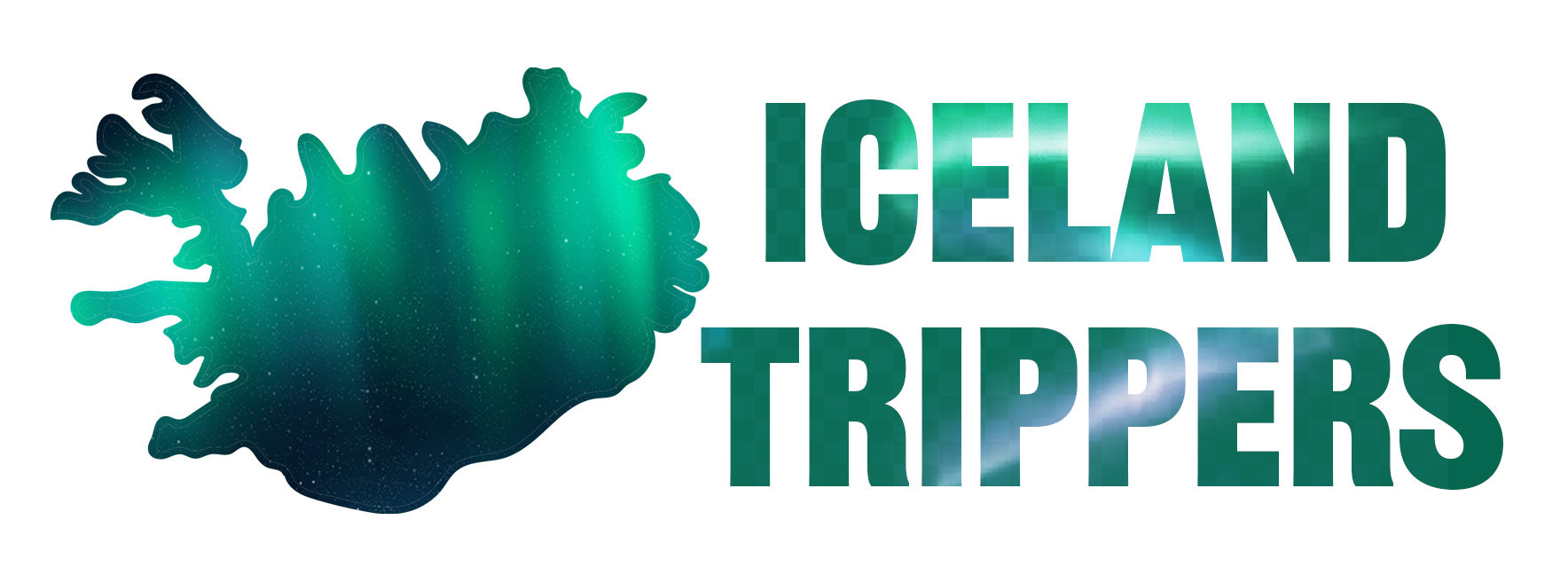
Learn how to easily plan your dream trip to Iceland with helpful guides and tips!
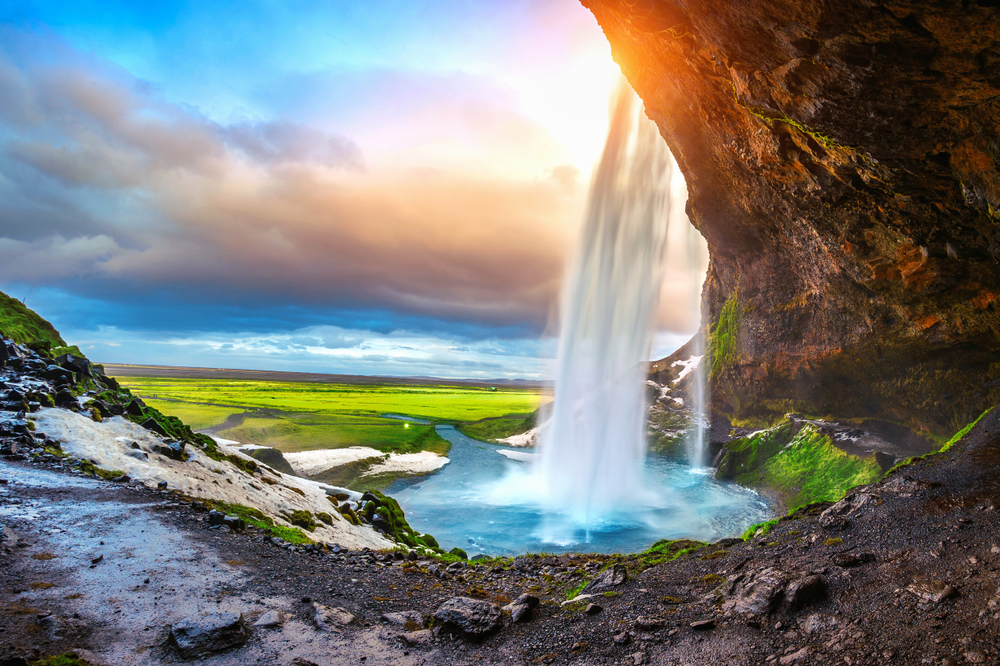

Best (And Worst) Time To Visit Iceland (Month By Month!)
February 19, 2022 // by Iceland Trippers // Leave a Comment
Deciding on the best time to visit Iceland for your needs is one of the most important parts of planning an Iceland trip. If you are unsure where to start, we have made it super easy for you by explaining what you can expect month by month.
This complete guide to the months and seasons of Iceland will fully prepare you for your trip. All of the most common questions are answered, such as when to see special things like the Northern Lights, lupine flowers, and puffins.
Planning your trip to Iceland last minute?
Make sure to book your hotels and tours in Iceland in advance to ensure availability! The longer you wait, the more difficult it gets. Here are my top picks for your trip :
Top Experiences And Tours In Iceland:
- Golden Circle Full Day Tour From Reykjavik (Likely to sell out!)
- Silfra Snorkeling Tour (Includes photos + only small group)
- South Of Iceland Full Day Trip (Our pick!)
- Whale Watching In Reykjavik (On a luxury yacht)
- Northern Lights Bus Tour (Great to go with a local)
- Ice Cave Tour And Glacier Hike (Likely to sell out)
Tickets You MUST book in advance:
- Keflavik > Reykjavik Bus Airport Transfer (Skip the line!)
- Sky Lagoon Entrance Ticket (Includes 7-step spa ritual)
- Blue Lagoon Entry Ticket With Drink (Likely to sell out!)
Top picks for places to stay in Iceland:
- Hotel South Coast (Great central location)
- Grandi Reykjavik (Includes free breakfast)
- Hotel Kria (Close to black sand beach)
- Hotel Skaftafell (Mid-range price)
Iceland is amazing , but it is also a country that must be taken seriously. Winter in Iceland is beautiful, but you must plan accordingly if that is when you are planning to visit. However, even summer has its drawbacks.
Not to worry, we have all the information you need to check off all of your Iceland dreams. The best months to visit Iceland might depend a little bit on the season, but it depends the most on you!
Get a FREE printable “Hidden Gems In Iceland” E-book by joining our private Iceland Facebook Group and sharing your photos and asking for tips and tricks.
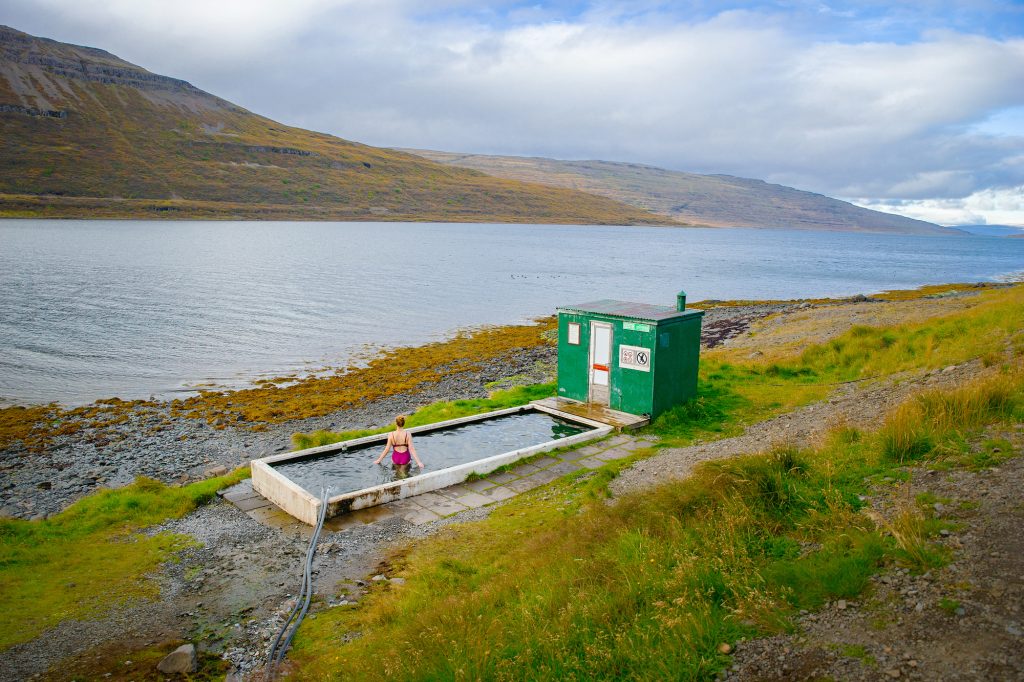
High and Low Seasons for Visiting Iceland
Like any popular tourist destination, Iceland has an “on” season and an “off” season. These times are otherwise referred to as high and low seasons (with the in-betweens being called shoulders).
The high season is when the majority of the tourists come to visit. This is generally due to the nice weather and ease of access. This is when most people plan their Iceland itinerary !
But just because the weather is colder in the low season does not mean you should not visit! Many people enjoy the low and shoulder seasons more because there are fewer crowds and it is cheaper, making it the best time to travel to Iceland for a lot of people.
You might be surprised to learn that there are indoor and outdoor activities for all of the seasons. Iceland is beautiful inside and out no matter when you visit.
High Season: June-August
Summer, summer, summer! This is the high season in Iceland for the obvious reasons: weather and temperature. It is undeniably the best weather to visit Iceland with much more sun and higher temperatures.
However, this is also by far the most expensive time to visit Iceland. Airfare, hotel fees, food prices–everything costs a pretty penny during the summer.
Not to mention the crowds. The high season is high season because it is when most people visit Iceland.
While the cost and the crowds are pretty big negatives, the high season has phenomenal positives as well. Especially if you are wanting to go to Iceland for the great outdoors. Most roads will be open during this time as well.
At the end of the day, it is all about your priorities. If weather and being able to spend the maximum time outside every day is your top priority, you are going to want to come to Iceland during the high season.

Shoulder Season: Sept-Oct & April-May
Shoulder seasons are the traveling industry’s best-kept secret. Okay, so it is not super-secret, but it still is not something people talk about as much as they should.
We hear about the high and low seasons all the time, but not so much about the shoulder seasons. They are the very beginning and the very ending of the classic tourism season.
This means that there are still more people than in the low season, but not the huge crowds of the high season. Prices are a little higher too, but still generally reasonable.
The best part of the shoulder season is that the weather is still reasonable. It may not be as great as the high season, but still totally tolerable!
Low Season: November-March
The low season in Iceland is during the typical winter months. For a country named after ice, Iceland’s winters are not that bad!
While there are some road closures, the country is still quite explorable and traversable during the cold months. And if you are coming to see the Northern Lights, this is the time to do it!
This is also the time to come if you are on a serious budget and need to take advantage of the low season prices. Traveling does not have to empty out your bank account.
The lack of crowds makes it the best season to visit Iceland on a budget! There are some trade-offs for coming during the off-season in Iceland, but there are some definite benefits too. This is actually our favorite time to go!
As we said above, the best time to visit Iceland depends on your Iceland priorities!
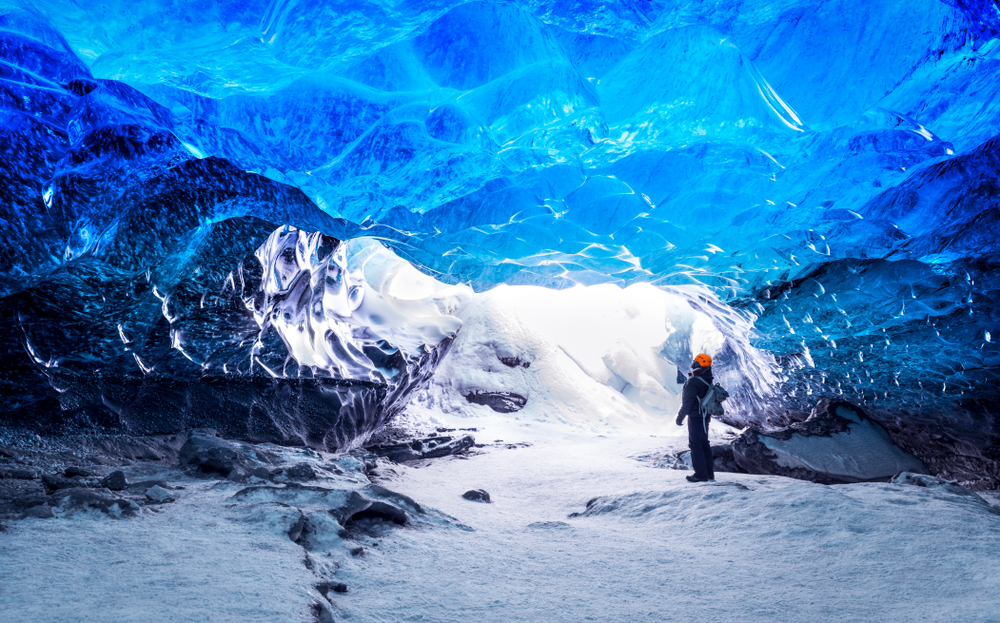
Visit Iceland in Summer if You:
-Love the idea of 24-hour sunshine. Ah, the midnight sun–you are not alone if this is on your bucket list ! If you have dreamt of Iceland’s 24-hour daylight, the summer might be the best time for you to visit.
-Are enamored with the brilliant green of summer. Iceland starts greening back up in the spring, but summer is the best time to visit Iceland if you want to see green everywhere.
The iconic lupine flowers bloom in June and July as well, creating swatches of purple across the landscape. If you want to photograph these flowers make sure to time your trip right.
-Want the best chance to spot whales. Whale watching is a popular tour in Iceland. The magnificent beasts can be spotted offshore from April through October, but the peak time to see them is in the summer.
In summer, more species are in the area and boat tours are less likely to get canceled because of weather.
-Plan on camping. Since the weather is calmer and less unpredictable during the summer, camping in Iceland is a better option for this season. You will have the least rainfall and less wind. This is especially good if you are tent camping.
-Are not bothered by crowds. Everyone loves the gorgeous, summer Iceland scenery. And we mean everyone . Iceland is a super crowded place in summer so keep that in mind.
If you hate crowds, you can still do alright coming in the summer. You will just want to visit the less popular places in the country. They may be less popular, but Iceland is amazing no matter where you go.
-Are totally invested in the traditional sense (read: financially). If you are not concerned about how much your trip to Iceland is going to cost, that saves you a lot of seasonal concerns.
Iceland is stunning in the summer, and we cannot blame you for wanting to visit when everything is so vibrant.
Just keep in mind that it is already expensive to travel to Iceland, let alone during the summer. During the high season, top tourist destinations and locations charge top dollar for everything.

Visit Iceland in Winter if You:
-Want to spot the Northern Lights. You can see the Northern Lights in the fall, but there is a caveat. You will have to stay up until around 2 am. If staying up all night is not your vibe, then winter is the best time to go to Iceland to see the Northern Lights!
In winter, there are not many daylight hours. The sun is only up from around 11 am to 3 pm. However, the increased darkness means a better chance of spotting the Northern Lights. Around midnight is the best time to spot them, but earlier or later is possible too.
-Want to visit an ice cave. The incredibly-formed ice caves are some of the best natural features in Iceland and can only be visited in the winter. Tours are lead from November to March.
-Love a good winter wonderland. There is just something magical about the way snow completely changes Iceland’s landscape. Many people absolutely love coming to Iceland during this time of year because of this.
If you love the beauty of winter, then it is the best time to visit Iceland! Keep in mind that snow has drawbacks since some roads will be closed.
-Want to stand out from the crowd. While a lot of people enjoy Iceland in the winter, the number of people who go is nothing compared to the summer.
If you are looking to do something a little different and unique, winter just might be the best time for your visit to Iceland. It certainly is not a bad time!

Visit Iceland in Fall if You:
-Do not like crowds but still want to see the Northern Lights. Even though this is the off-season, it is prime viewing time for the Northern Lights.
This is because the weather is so nice! You do not have to freeze to see the Northern Lights, just come during the fall.
An extra bonus is that there are really not very many tourists during this time. Fall is the best time of the year to visit Iceland if you want to miss the crowds and do not mind coming when it is a little colder.
-Love fall colors. Iceland is not a country that is typically praised for its fall foliage, mostly because there are not many trees. However, what trees there are turn golden along with the grasses, to create a beautiful landscape.
-Want to experience the Iceland Airwaves music festival. If you have not already heard about it then you might not know what a big deal the Iceland Airwaves music festival is. But if you have heard of it then you already know that it is a must-see!
It is a super popular music festival that happens each fall in Iceland. Usually, it is held sometime in November, but do an internet search to find the exact date.
If you love music, this festival is a great addition to your Iceland plans! Fall is the best time to go to Iceland to check it out!

Visit Iceland in Spring if You:
-Love puffins! Spring is the best time to visit Iceland if you want to see puffins . These adorable birds start arriving around April for their yearly nesting.
Puffins are some of the cutest birds out there, and you can find them all over! If you are coming to catch sight of or photograph them, just check in advance to make sure they will be in the area where you are going.
-Want to road trip without snow. As we said above, some of the roads can close in the winter. Spring is the best time to come to Iceland for better weather and open roads. That melting snow also helps to make the waterfalls flow stronger.
Not to mention that the world is coming back to life in the most beautiful way! There is something about the colorful bursts of color against the gray of winter that makes spring like no other season.
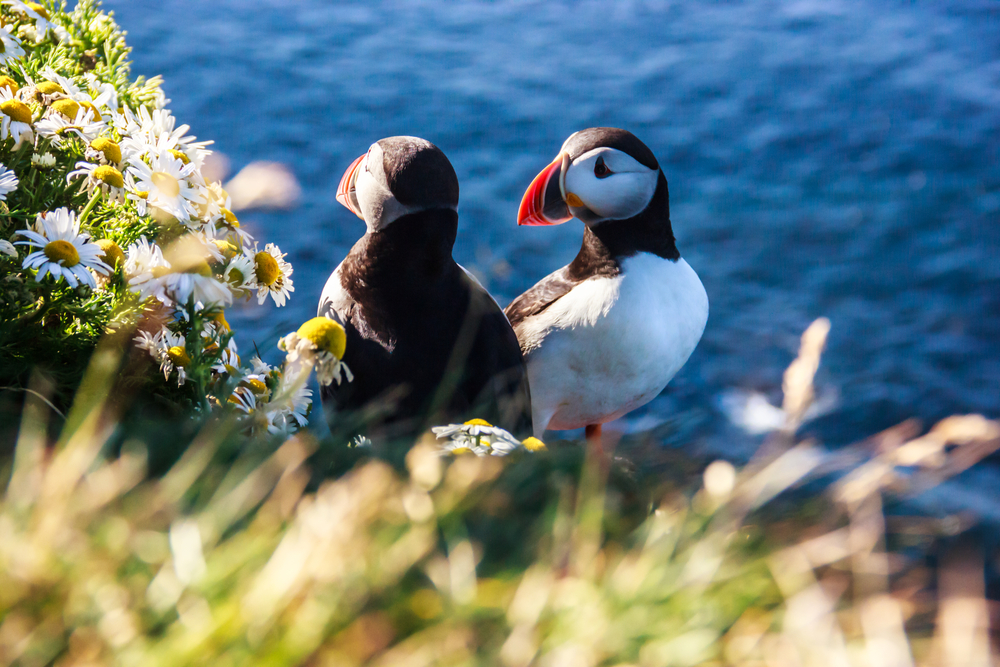
Best Time to See Northern Lights in Iceland
If you are interested in the Northern Lights, you are interested in Iceland! While there are many different places to see the Northern Lights in the world, Iceland is hard to beat.
Especially considering that there are places where you can watch them from a hot tub! The Northern Lights In Iceland are a huge draw, and if they are the reason you are coming you are not alone!
If you are wondering what is the best month to see the Northern Lights in Iceland, there are a few choices. It is possible to see the Northern Lights any month between the end of September and the end of March.
Just like the sun is out all night during summer, the nights are very long in the winter. The closer to mid-winter you visit, the longer the night and thus the higher chance of seeing the lights.
You definitely will not be able to see them during the summer! Winter is when you should book your Iceland trip if the Northern Lights are a priority.
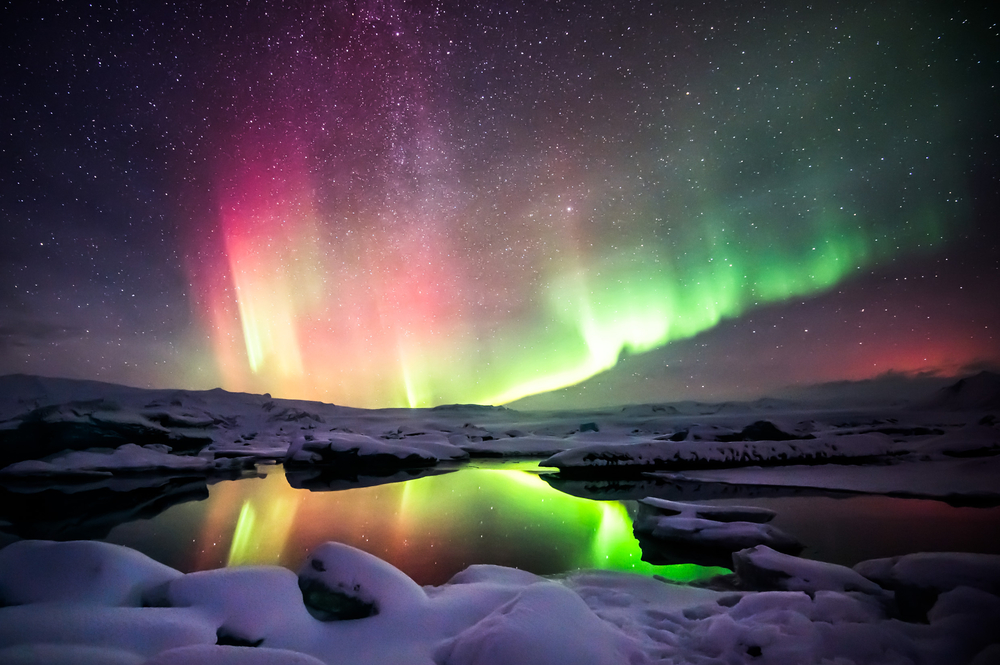
Cheapest Time to Visit Iceland
Unfortunately, Iceland is one of the more expensive countries to visit. We have gone over and over because we believe the experience is worth the money .
However, there are things you can do to make your trip much less expensive. One of those things is visiting during the Iceland off-season.
If it is your goal to do Iceland without dumping a ton of cash, we absolutely recommend the shoulder seasons or winter. Visiting right before or right after the high season of summer can save you a lot of money.
If saving money is a high priority, winter is absolutely the best time to visit Iceland. And pro tip: use grocery stores to cut down on costs even more!
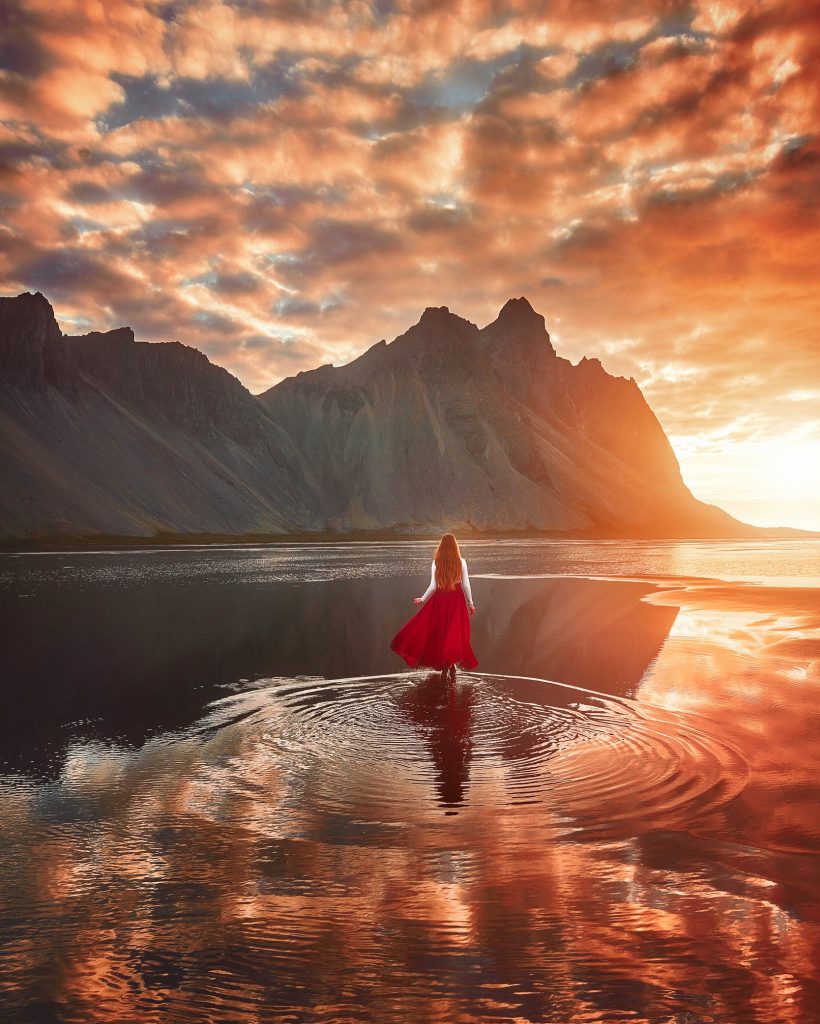
Iceland Weather Breakdown by Month
So far we have been referring to entire seasons, but we know that is kind of broad. Especially when you are planning the trip of a lifetime!
That is why we are going to break everything about Iceland Weather down month by month . This way you can know exactly what to expect.
After all, sometimes the best time to visit Iceland is simply when it best fits into your life. Whenever you make the trip, our month-by-month breakdown will help you make the most of it.
Iceland Weather in January
Happy New Year! January is a great time to visit Iceland. During this time of year you will find highs of about 36 ° F and lows of about 27 ° F.
Is that warmer than you expected? For a country named after ice, Iceland’s winters are actually quite moderate when compared with a lot of other places in the world!
That being said, January in Iceland is the coldest and windiest month. You will want to bring warm clothing and dress appropriately! Expect lots of snow and ice.
Iceland Weather in February
Honestly, the temperatures do not change much in February. What does change is the hours of daylight!
At the beginning of January, you will only get about 4 hours of daylight a day. By the end of February, this increases to about 10 hours.
February is a great month to come because there is more daylight but the crowds and costs are still at a minimum. Check out our post on things to know before you visit Iceland in February!

Iceland Weather in March
March continues with the increase in daylight hours, with about 13 hours of sunshine a day by the end of the month.
Winter weather continues in Iceland in March , although it starts sticking more to the mountaintops and less to the streets. As with most places, the weather is also better in southern Iceland than in northern Iceland.
However, it is still cold pretty much everywhere. We are getting closer to spring, but you would not really know it yet. The temperatures are still averaging between 27 ° F and 36 ° F.
Iceland Weather in April
The weather finally begins to make a bit of a change in April. Temperatures range between 32 ° F and 41 ° F during this warmer month.
What is more, there is a lot less snow! Spring starts to show its face about this time, with the country beginning to green back up again. Migratory birds start to return, including puffins.
We are also looking at around 17 hours of daylight in April as we officially move out of the low season and into the shoulder season. Don’t forget to check out this post about visiting Iceland in April!
Iceland Weather in May
May is seriously one of the best times to visit Iceland! Especially if you love the sun! The days have 20 hours or more of sunlight. It is also the driest month, with the least rainfall.
The highs are also much closer to 50 ° F, which means you almost do not even need a jacket depending on where you are from.
Of course, you will still want to bring your jackets . While the weather is much more temperate, there will still be some cold days. However, it is totally livable and the country is also becoming so much more green!
Iceland in May is also still shoulder season, which means you will not have to try so hard to find your own space while enjoying the sunshine.
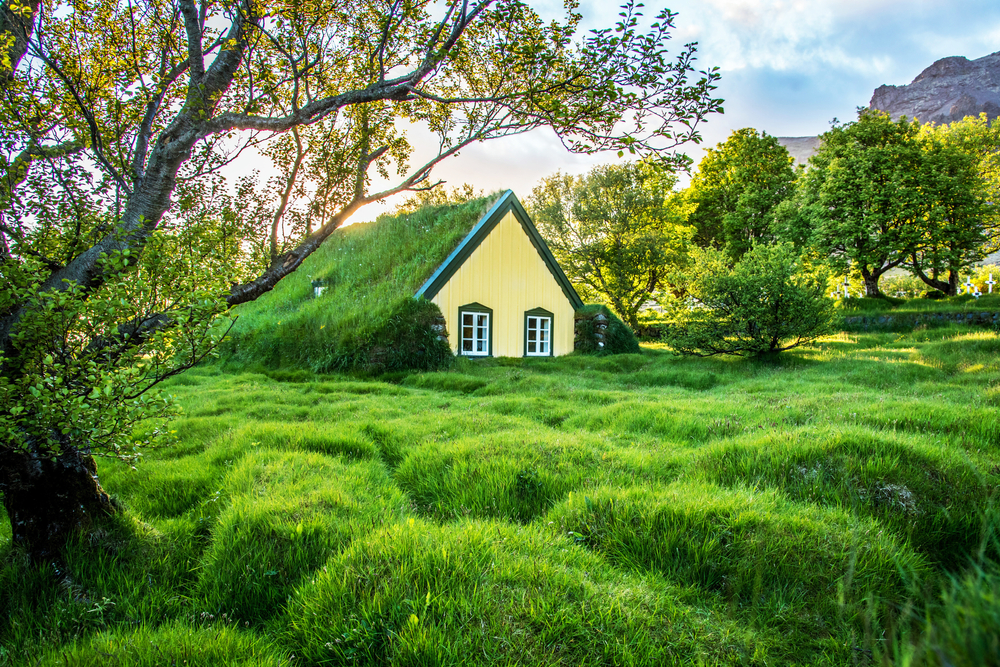
Iceland Weather in June
Welcome to high season! While it is called the high season because it is most popular among tourists, June in Iceland is also the high season for the longest days.
If getting the most out of each day is important to you, then June is the best month to visit Iceland. You can explore for many more hours in daylight.
June nights only last for about 3 hours, beginning around 11:30 PM! Yeah, blackout curtains are a big thing in Iceland summers!
While the highs average around 52 ° F, they can get much higher than that. June is the beginning of summer, and also the beginning of real warmth.
Iceland Weather in July
Now, if you are interested in heat rather than warmth , July might be a better time to visit Iceland. It is the best time of year to visit Iceland for heat, as the hottest month of the year. It is also the least windy month.
The weather in Iceland in July is generally extremely pleasant during this time of the year. While the nights are a little longer, at about 4 hours long, they do not increase by much!
Keep in mind that “hot” does not mean the same thing in Iceland as it does in other places. The average highs are around 56°F. That is part of why it is one of the most popular times to visit because it does not get any warmer than this.
Iceland Weather in August
August is the last month of the high season. While the beginning of the month is still as warm as July, temperatures start to go down by the end of the month.
August is the best time to go to Iceland if you do not mind the crowds due to the fairly standard daylight hours. The sun sets around 9 PM and rises around 5 AM. August has the least cloudy days as well.
Do keep in mind that August in Iceland goes quickly from summer to fall. By the end of the month, the slight bite to the air will have you wishing for warm pumpkin pie and spiced apple cider.
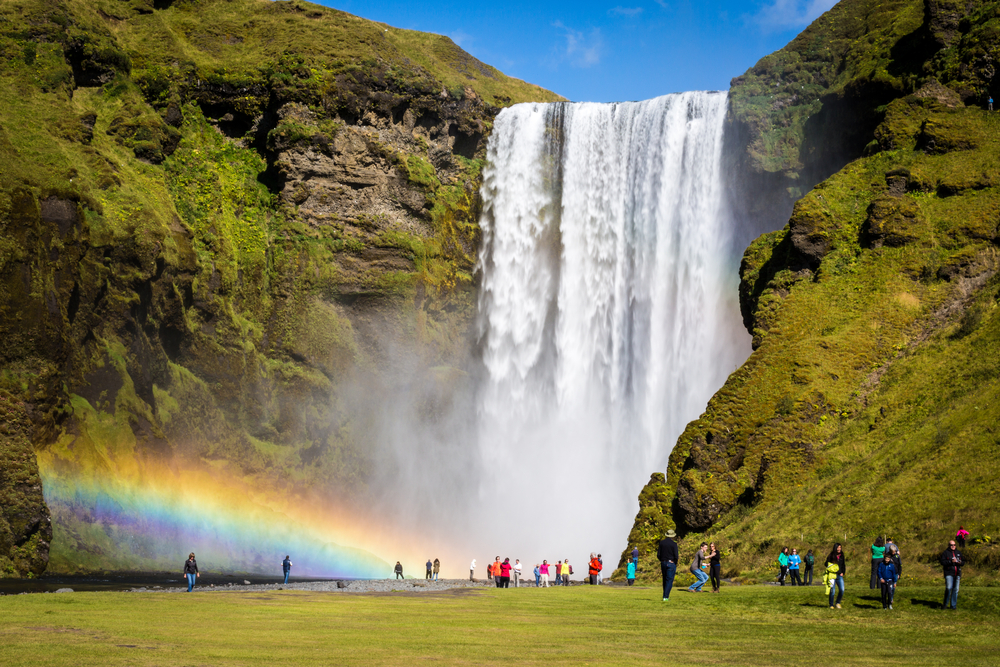
Iceland Weather in September
September still has great sunshine for Iceland, but it does go down to just below 12 hours by the end of the month. It is the warmest month with a chance to see the Northern Lights.
Temperatures are still quite nice, and we are back in shoulder season. This means that you can enjoy the nice weather and decent daylight hours without all the crowds of summer.
By the end of the month the likelihood of snow increases. If you visit Iceland in September , you will want to pack your warm clothing!
Iceland Weather in October
October in Iceland is still technically part of the shoulder season, but it is starting to feel much more like the low season of winter. Daylight is down to about 8 hours a day.
In addition, the average temperature is dropping back down to about 41 ° F. While it is not absolute winter yet, the weather should be taken into consideration at this point.
Bring warm clothes and waterproof ponchos. October is the wettest month in Iceland with an average of 14 days with precipitation.
Although it is colder, October is the best time to visit Iceland if you want to explore with as few crowds as possible. The roads are still open and you can still go pretty much everywhere you want.
Iceland Weather in November
Welcome to winter and the off-season in Iceland. November begins the coldest time of the year, although December and January are colder. This is when the snow starts to fully cover the island.
The average temperature is 38 ° F, but it can get much colder. Daylight only lasts about six hours.
We love to visit Iceland in the low season, and really do think it is one of the best times to visit Iceland. You just have to be prepared for the lower temperatures and the weather.
Iceland Weather in December
The last month of the year is one of the coldest months, second only to January. Temperature highs only reach about 39 ° F. It gets as cold as 21 ° F.
In addition, Iceland in December sees quite a lot of precipitation and snow. Daylight hours are generally pretty short.
However, this does make it and January the best time to visit Iceland for the Northern Lights! However, it is also the cloudiest month, meaning the lights can get obstructed.
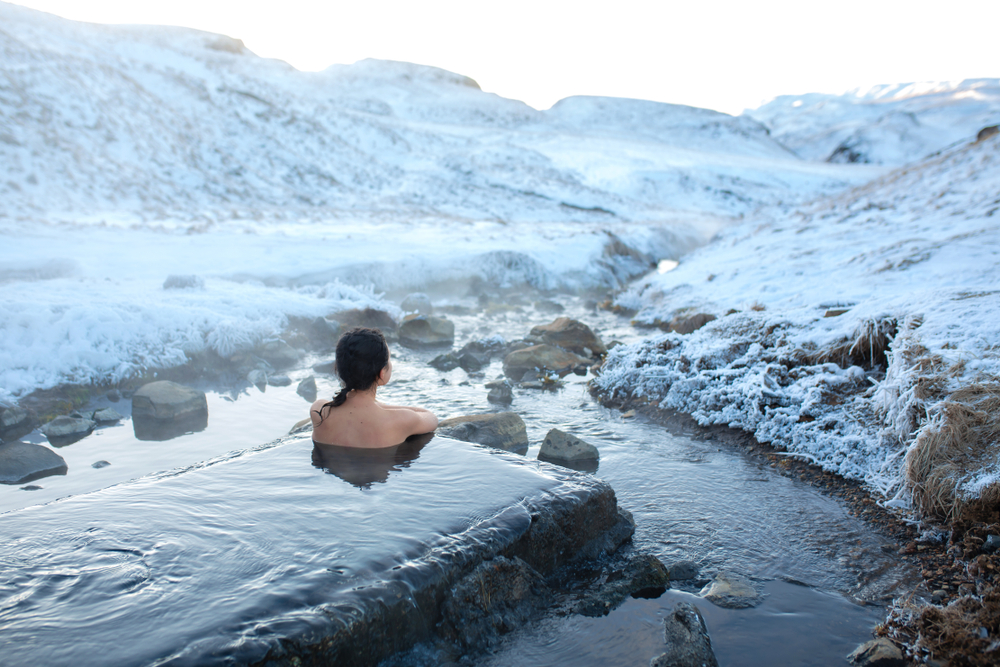
Iceland Events and Activities by Month
While the weather is a big deal, sometimes it is not as important as what you can do. After all, most weather is survivable if you plan and dress accordingly.
If you are more curious about what is going on than what temperature it will be, we have you covered! We have broken down the events and activities you can do during each month of the year.
You might be surprised by some of your options, especially during the winter!
Iceland in January
Can you even go wrong with New Year’s Eve when you are celebrating in a different country? Especially Iceland!
The country takes this holiday seriously with partying on New Year’s Eve, sleeping on the first, and shopping on the second.
And then there is Christmas–that is right, Christmas extends into January in Iceland, with the last day being on the 6th. If Christmas is your favorite holiday, then the end of December and the beginning of January is definitely the best time to visit Iceland.
Another great January tradition in Iceland is Thorrablot . This pagan celebration was canceled when Iceland went Christian but has had a resurgence in the last couple of centuries.
It is a week-long celebration of an Icelandic tradition that will not disappoint. If you want to feel like a local, prepare yourself for some things you have never eaten before, like rotten shark meat, boiled sheep’s head, and congealed sheep’s blood.
Iceland in February
February is beloved for the Winter Lights Festival . As a celebration of bright and happy things, you will love the way they light the streets with brilliant fluorescence to chase the darkness of winter away.
Öskudagur is basically Icelandic Halloween. The kids dress up in great costumes, and instead of the “trick or treat” chant, sing for their candy.
The Icelandic Food and Fun Festival is a fantastic festival that celebrates Icelandic cooking. And not even the kind that uses blood and rotten shark meat! It is all about using ingredients native to Iceland and enjoying all the culinary joys the country has to offer.

Iceland in March
Did you know that Iceland had its own prohibition period? Beer with an alcohol level of over 2.2% was banned for the majority of the 1900s but legalized again in 1990.
Iceland celebrates this legalization with the unofficial holiday, Beer Day, on the first of March every year! We think you can probably guess what the main activities are. (Drinking beer.)
DesignMarch is similar to the Food and Fun Festival in that it is a celebration of Icelandic creativity. The event features purely Icelandic products and goods.
Continuing in a similar fashion, the Reykjavik Folk Festival honors centuries of traditional music and song.
Iceland in April
Iceland celebrates Easter for days just like Christmas. Honestly, we do not know why more countries do not do holidays like this! Celebrating with just one day is so minimal!
Easter lasts from Holy Thursday to Easter Monday in Iceland. It is generally spent with family, rather than with huge parties.
April’s other holiday is the first day of summer. Given the dark of winter and the light of summer, and the very small in-betweens, Iceland actually does not traditionally recognize spring and autumn as seasons. So summer starts in April!

Iceland in May
The Reykjavik Art Festival is a big deal in May! People come from all over the world to participate in and experience creativity and fun.
If art is not your thing, May still might be the best time to visit Iceland with the Rite of Spring Festival. We know, we know, we just told you there is no spring in Iceland.
But when Iceland gave up its traditional calendar, they adopted spring and autumn into their new calendar. And they like to welcome spring with heartfelt jazz and folk music!
Iceland in June
It should come as no surprise that a country that willingly eats rotten shark meat celebrates the sea! Iceland’s Festival of the Sea happens in June, and it honors the country’s long tradition of seafaring.
Iceland also celebrates its independence from Denmark every June 17th. Like the 4th of July in the United States, Iceland National Day is a country-wide affair filled with parades, concerts, and general enjoyment of Icelandic culture.
Summer Solstice takes advantage of the Midnight Sun with all-night rock concerts. You can also join the locals in watching the sun set and rise all within the course of 2-3 hours.
Another unique Iceland festival is the International Viking Festival . It is a days-long holiday event that pays tribute to Iceland’s fierce Viking history.
Iceland in July
Innipukinn Festival is another music festival that happens in July. If you are not already getting the sense that you can hit up a music festival basically anytime you visit Iceland, well, you can. Icelandic people really love their music, okay?
They mix things up a bit with LungA , a festival specific to the Icelandic town of Seyðisfjörður . This festival still has music (as any good festival does) as well as art!

Iceland in August
Verslunarmannahelgi–say that five times fast, we dare you! Honestly, if you can pronounce it once we will be impressed. Verslunarmannahelgi happens the first weekend of August and is a quick bank holiday (kind of like Labor Day in the US). People generally celebrate by going camping.
Gay Pride comes the second weekend of August, and nowhere celebrates it as Reykjavik does! With parades, parties, and concerts, this is truly a vibrant and fantastic event.
If you like running, (like, really like) then the third weekend of August is the best time to visit Iceland! This is when the Reykjavik Marathon occurs, and it is another event that attracts people from all over the world!
The marathon wraps up with Menningarnott , a fantastic cultural celebration with cultural events, fireworks, and you guessed it, great music!
Iceland in September
The capital city of Reykjavik has two festivals in September, making it the best time to visit Reykjavik if you are wanting to have some fun during the shoulder season.
First is the Reykjavik International Literary Festival . This one is not just a big deal to Iceland, it is actually the biggest literary festival in Northern Europe!
Next is the Reykjavik International Film Festival . There is just something about literature and film that make them go hand in hand. Both of these festivals draw people from all over the world, but especially the film festival!
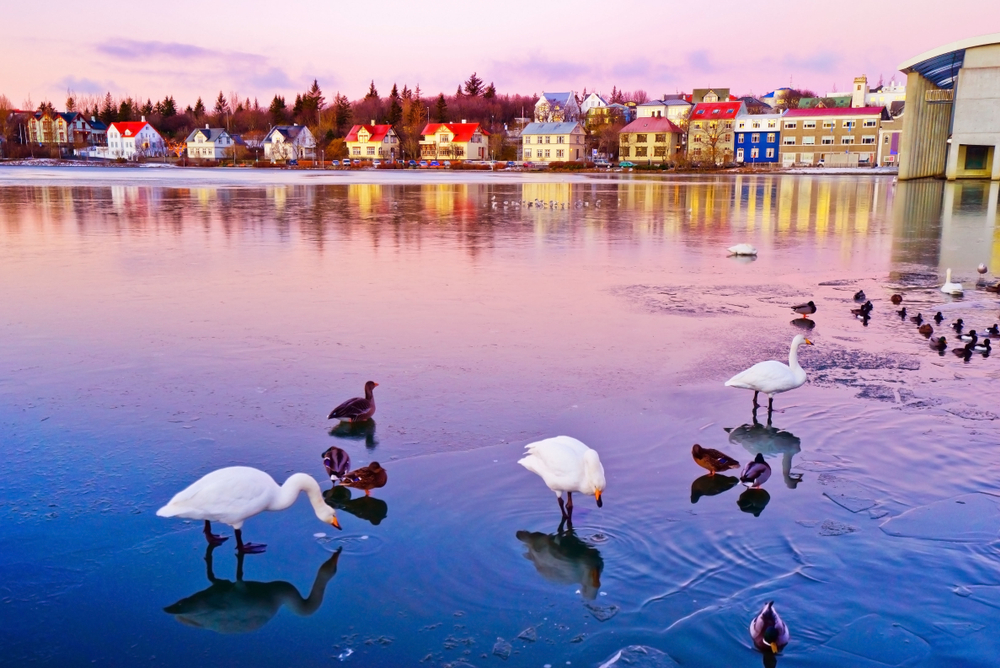
Iceland in October
Iceland Airwaves is another music festival but centers on indie and alternative music rather than the traditional folk and rock music of so many other festivals. Of course, folk and rock music still abound!
Iceland also celebrates Halloween in October, although they have not been celebrating it as long as other countries and do it a little differently. It is more of an adult holiday, but still features costumes!
Iceland in November
November does not have a whole lot going on in the realm of festivals and events. What it does have, though, it makes sure to do well.
Frostbiter is Iceland’s Horror Film Festival. So while Iceland does not have much going on in November, it is still the best time to visit Iceland if you love horror!
Iceland in December
Sorry not sorry, but Iceland has the best Christmas lights. Seriously, you have to check them out! Because the country is so dark all the time in December, they go all out with the Christmas lights.
And the way they make such a contrast against the dark? Unbeatable.
Everything about Iceland Christmas is simply unbeatable. From the concerts to the food to the country’s own unique and fun traditions, you will absolutely love it.
New Year’s Eve is filled with fireworks, bonfires, and singing. There are even costumes!
And they do not wrap things up and go to bed at midnight. Iceland New Year partying lasts long into the early hours of the next day.
December is the best time of year to travel to Iceland if you love all the December holidays!
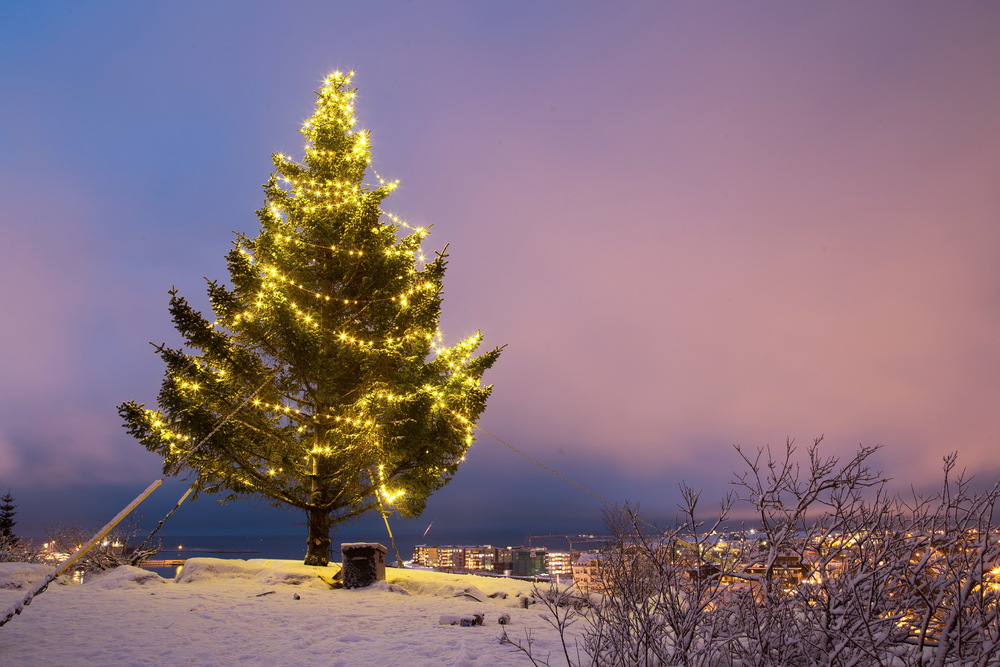
When is the Worst Time to Visit Iceland?
Honestly, there is really no bad time of year to visit Iceland as long as you plan accordingly. After reading this article, you should have a good idea of what each month has to offer in terms of weather, natural events, and festivals.
As long as you visit when you want to and pack according to the season , you will be in Iceland at the right time.
If you want to see the Northern Lights, summer is the worst time to visit Iceland. But, if you want clear roads for your rental car and warm weather, then winter is the worst time to visit.
So, When is the Best Time to Visit Iceland?
At the end of the day, the best time to visit Iceland is 100% up to you! Whatever your interests are and your budget will determine when you should visit this amazing country.
After all, this is your trip to Iceland. Plan it around what you want to see and do.
Do you want the midnight sun and purple, lupine flowers? Come during summer. Hate crowds and overpaying, but want decent weather? Give shoulder season a try. Does your Iceland bucket list involve the Nothern Lights or ice caves? Winter is your best bet!
Iceland is gorgeous year-round, and you really cannot go wrong no matter when you visit!

We hope our guide to the best time to visit Iceland has been helpful! Feel free to let us know when you decide to go in the comments below. What is your favorite time to travel to Iceland?

Reader Interactions
Leave a reply cancel reply.
Your email address will not be published. Required fields are marked *
Save my name, email, and website in this browser for the next time I comment.
When is the best time to visit Iceland in 2024?
Mar 7, 2024 • 5 min read
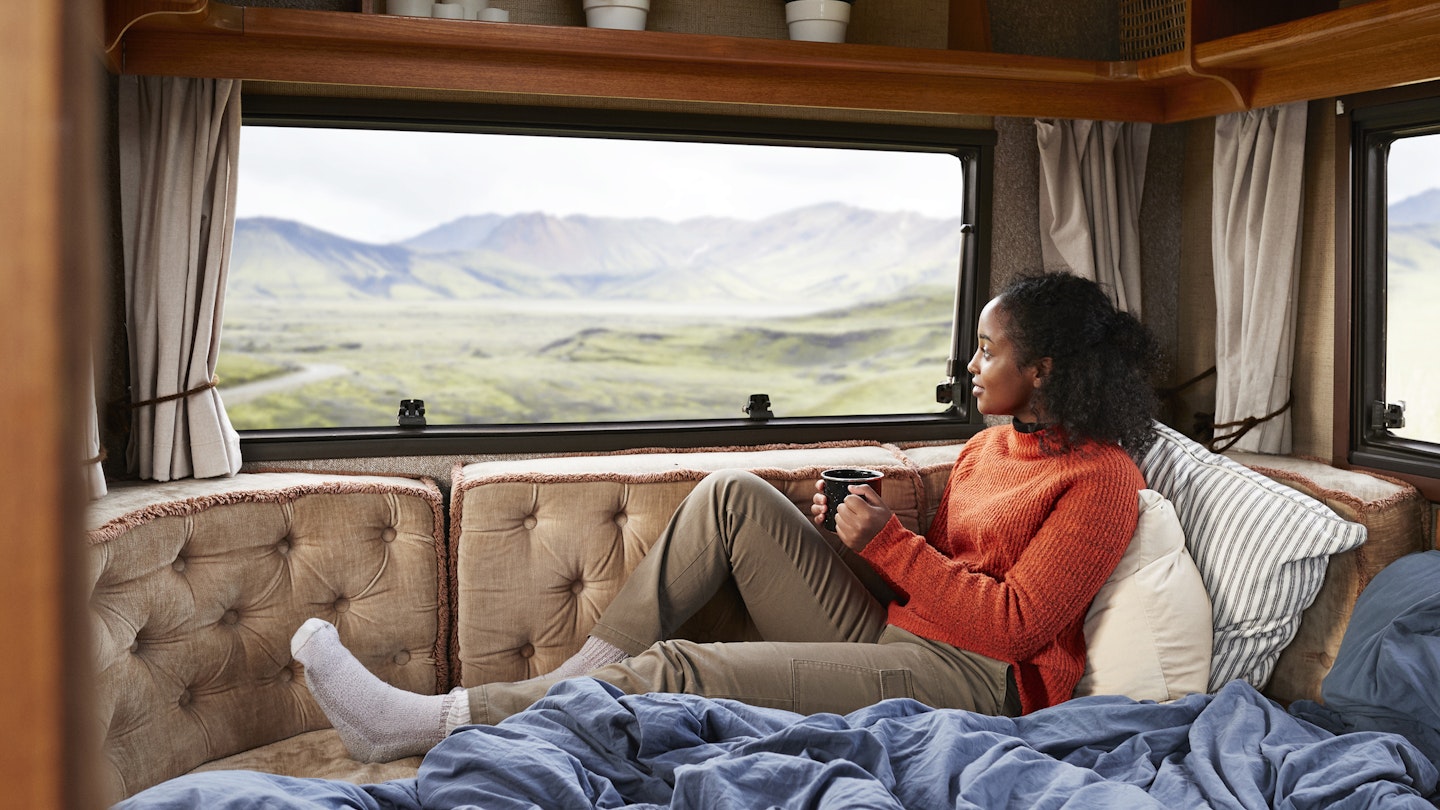
Summer is the best time to take an Iceland road trip © Klaus Vedfelt / Getty Images
There’s no such thing as the perfect time to visit Iceland as the weather is notoriously whimsical and the best season for your trip depends entirely on what you want to experience.
Mid-summer is glorious with eternal daylight courtesy of the midnight sun. This is the time for hiking, camping and exploring the wilderness, and when most services are open. The down side is many destinations will be packed with tourists.
We've got all the information you need about the highs and lows of different seasons. Whenever you choose to visit Iceland, pay attention to forecasts and road conditions and follow any safety advice issued by Icelandic authorities .
December to January is best for seeing the Northern Lights
Christmas lights brighten up the darkness and a festive spirit is in the air as the dark season nears its peak. Frost glitters and snow transforms landscapes into winter wonderlands. Christmas markets are held in Heiðmörk outside Reykjavík, in Hafnarfjörður and on Ingólfstorg square in Reykjavík, which has the added bonus of an ice rink. If conditions are right, the first ski resorts open up.
The sparse daylight means that you have a better chance of seeing the Northern Lights, especially outside populated areas where there is less light pollution (find a Northern Lights forecast here ). Joining tours is advisable. While it is possible to drive yourself, road conditions are often slippery and snowstorms are common.
Festivals worth checking out in winter include Dark Music Days and þorrablót mid-winter feasts, celebrated around the country. For the brave, restaurants often serve special þorri food.

February to March is the best time for snow sports and hot springs
It’s still dark and cold so communities brighten up the darkness with events like the Winter Lights Festival in Reykjavík and List í ljósi festival in Seyðisfjörður in the East. In narrow fjords in the Eastfjords and Westfjords, inhabitants celebrate the return of the sun with sólarkaffi and have pancakes. Snow sports become more enjoyable as daylight gradually returns.
Spring is an abstract concept in Iceland as the weather doesn’t always play along. It can still be cold and snowy, but the days get longer and the sun sometimes shines on skiers – this is often the best time for snow sports. The first of the migrant birds arrive and slowly but surely, nature springs back to life. Around Easter, events like Easter egg hunts are a fun family activity. In Ísafjörður, the Aldrei fór ég suður music festival is held and Ski Week is around the same time.
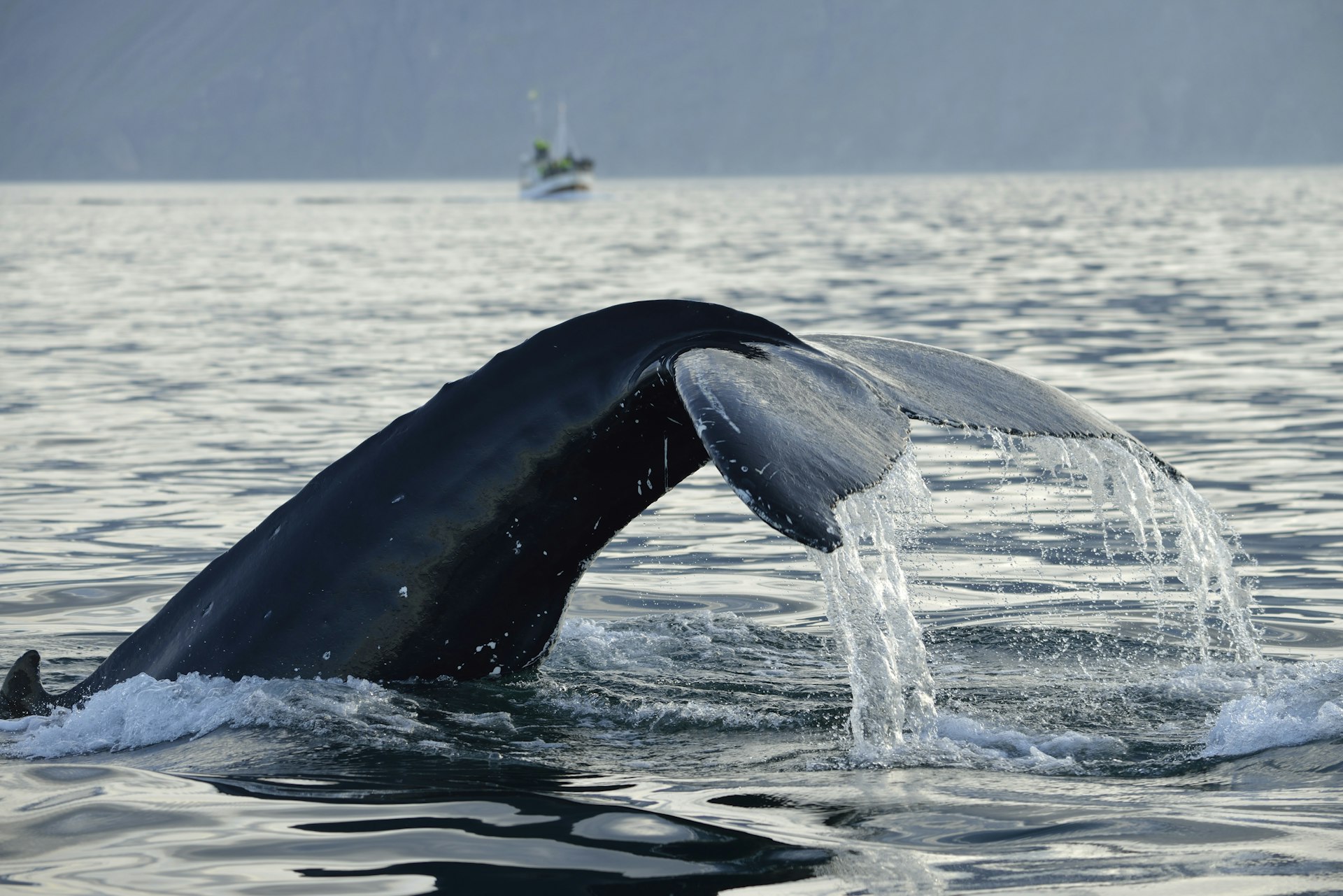
April to May is the best time for off-peak travel
While the weather is still unreliable, temperatures gradually rise. The first flowers blossom and trees bud. Migrant birds arrive in flocks and lambs and foals are born. Migrant whales have also returned and with better weather, whale watching is more enjoyable. The bird-watching season begins, although some areas may be closed due to nesting.
There are relatively few tourists around and if conditions are good, this can be a good time for a road trip . Look out for off-season discounts on accommodation and activities. However, not all tours and services have opened up yet.
The first Thursday after April 18th is the official First Day of Summer in Iceland, which is celebrated with parades and events around the country – even though the weather rarely plays along.
June to August is the best time for outdoor recreation
While there’s no good weather guarantee, this is your best chance of sun and warmish temperatures. Late June to early August is when most Icelanders go on vacation, filling up campgrounds wherever the best weather is forecast. This is the height of the tourist season – and height of the whale-watching season – so whatever you have planned, it’s best to book ahead.
Expect crowds at the most popular destinations, like on the South Coast and the Golden Circle . But as it’s bright all night, you can beat the crowds by traveling either super early or late. In July, Highland roads open up, but you'll need to book a tour or hire a 4WD vehicle equipped for F-roads and crossing rivers (if that’s your plan). Summer is the best season for hiking, biking and horseback riding. Around mid-August, wild berries ripen.
Summer is also festival season. Fishermen’s Day is a national celebration held in every seaside town on the first weekend of June. Around June 21, summer solstice is celebrated on Grímsey island, Iceland’s northernmost inhabited island. The Reykjavík Arts Festival is held every other year – the next one is on in June this year (2024).
Bræðslan music festival is held in Borgarfjörður eystri on the last weekend of July. Verslunarmannahelgi is a weekend in August that is packed with festivals and events, and Reykjavík Pride has various events held throughout the city, culminating in the Pride Parade.
Reykjavík Culture Night and the Reykjavík Marathon are held on the third weekend of August.
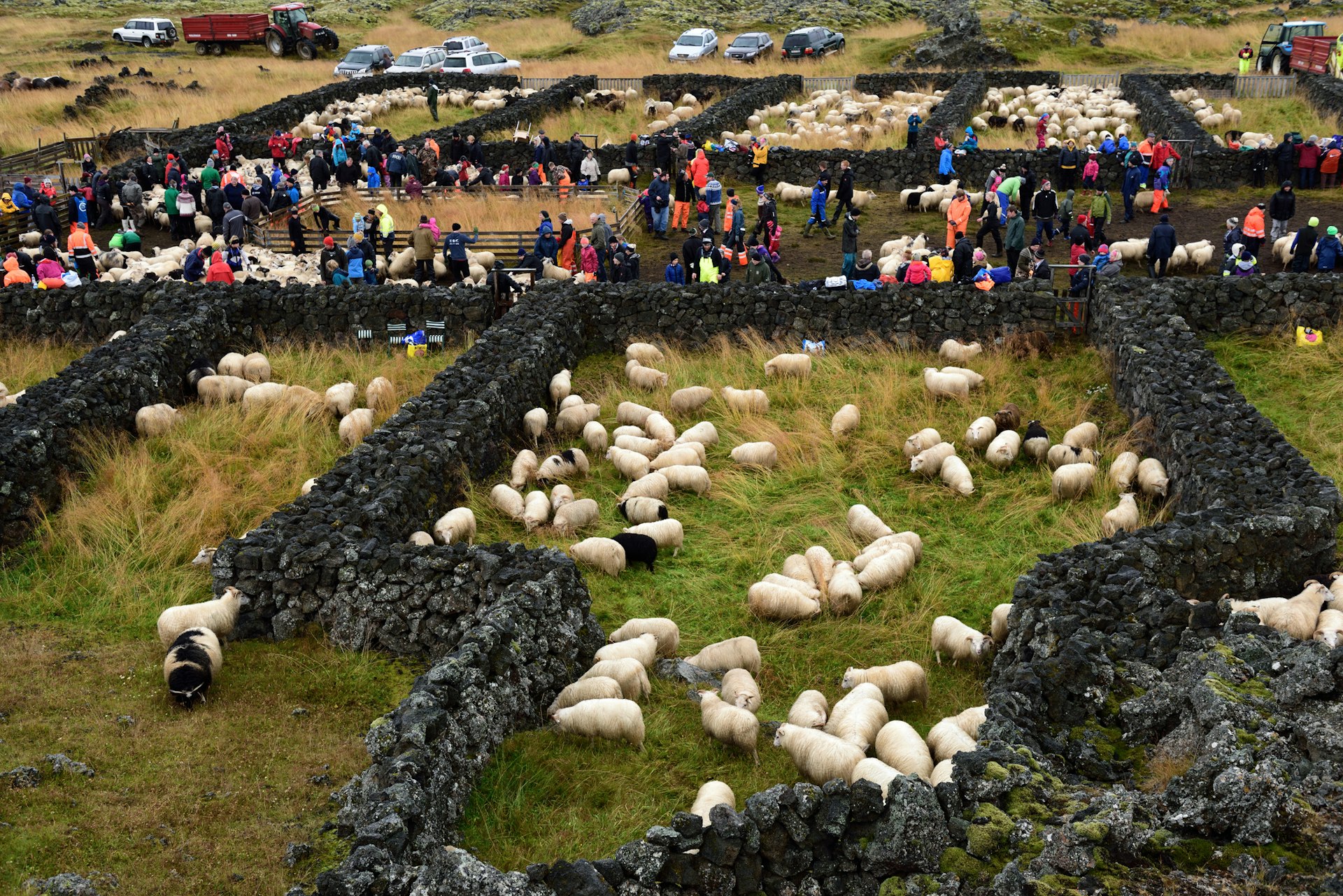
September to November is best for cultural events
Nights grow colder and camping is no longer advisable as fall rolls into winter. The weather is often good, though, so hiking can still be enjoyable. Pay attention to weather forecasts and bring warm clothing. Nature starts to change colors, painting forests and heather yellow, orange and red. Þingvellir National Park is at its most beautiful.
Road tripping is still possible and there will be fewer travelers around. However, winter is around the corner, so roads get slippery as soon as the temperatures drop and conditions can get stormy.
Réttir sheep and horse roundups are held in the countryside, and the Reykjavík International Film Festival takes place in the capital. In East Iceland, the Days of Darkness festival is held around Halloween and the Iceland Airwaves music festival is held in Reykjavík. Advent is approaching and Christmas preparations begin. This is a great time for visiting galleries and museums, going to concerts, relaxing in heated swimming pools, and feasting on good food.
This article was first published February 2021 and updated March 2024
Explore related stories
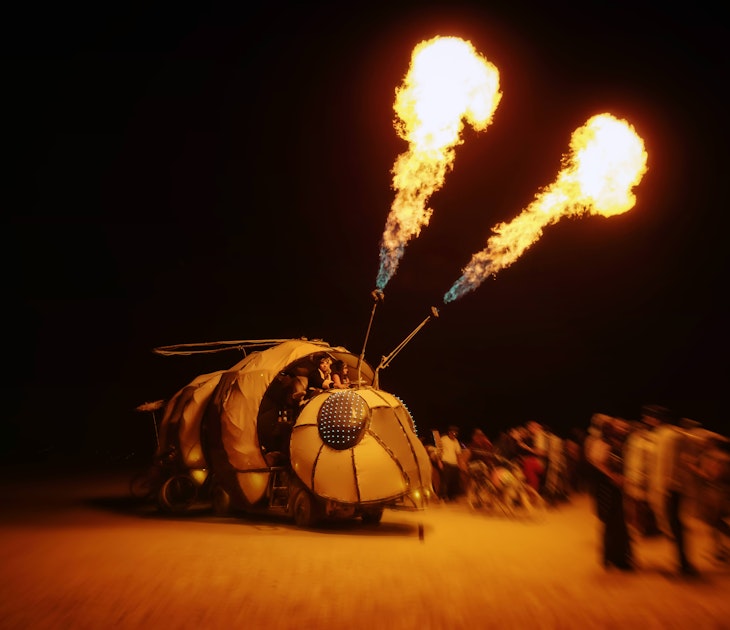
Jan 2, 2023 • 12 min read
Want to start planning for the year ahead? Featuring sports events, natural phenomena and more, these are 20 amazing trips to consider taking in 2023.
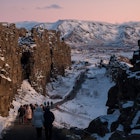
Mar 31, 2024 • 12 min read

Mar 31, 2024 • 6 min read

Mar 30, 2024 • 4 min read

Mar 28, 2024 • 17 min read
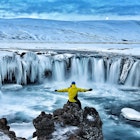
Mar 12, 2024 • 8 min read

Mar 6, 2024 • 9 min read

Mar 4, 2024 • 10 min read

Feb 19, 2024 • 7 min read
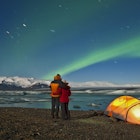
Feb 6, 2024 • 7 min read
We’re in Myanmar right now and it’s SO epic… click here to follow along on Instagram.
- Meet the Team
- Work with Us
- Czech Republic
- Netherlands
- Switzerland
- Scandinavia
- Philippines
- South Korea
- New Zealand
- South Africa
- Budget Travel
- Work & Travel
- The Broke Backpacker Manifesto
- Travel Resources
- How to Travel on $10/day
Home » Europe » Best Time to Visit Iceland – MUST READ • 2024 Guide
Best Time to Visit Iceland – MUST READ • 2024 Guide
Iceland, the Land of Fire and Ice, is a land of extremes. From the midnight sun to the Northern Lights, and from striking volcanic landscapes to incredible wildlife, this far-flung island is a feast for the eyes.
Because the seasons vary so dramatically this far north, choosing the best time to visit Iceland is really going to depend on what you’re heading there to experience. But no season should be discounted as there’s plenty to see at any time of year.
While a visit to Iceland is off the well-worn tourist path, certain experiences and seasons attract a large number of tourists and should be booked well in advance.
Winters in Iceland are brutal, but if you’re well prepared with the right gear it can be a very rewarding time to visit, not only to see the Northern Lights. Hiking and whale-watching are best done in the summer when there are also loads of festivals to check out.
If you need help deciding on the best time to visit Iceland to get the experience you’re been dreaming of, read on. We’ve gathered all the details to help you choose that perfect time that balances cost, climate, and crowds.
Best Time To Visit Iceland – May-August
Best Time To Go To Reykjavik – September–October
Best Time To See the Northern Lights – October-November
Best Time To Do the Golden Circle – Spring (May–June), autumn (September–October)
Best Time For Sightseeing – May–mid-June, September
Cheapest Time To Visit Iceland – Spring (May–June), autumn (September–October)
When is the Best Time to Go to Iceland?
When to visit iceland – a month by month breakdown, faq about the best time to visit iceland, final thoughts on the best time to visit iceland.
The best time to go to Iceland for great weather is during the summer, between May and August. The days are at their longest, so you can cram plenty more sightseeing in, and the temperatures are pleasant and mild.
This is also the peak tourist season for backpacking Iceland , so prepare for large crowds of tourists at sightseeing spots and attractions, not to mention the increase in prices for hotel rooms and flights. Of course Iceland is never cheap even in low season.
Late spring and early autumn offer a great compromise – all the benefits of mild weather without the peak season crowds and inflated costs. April to May and September to October offer this perfect balance – ideal for sightseeing. Yes, the days are slightly shorter and it may be a little cooler, but your reward will be a far more relaxed and budget-friendly experience.
For me, it’s the perfect place to explore in October !
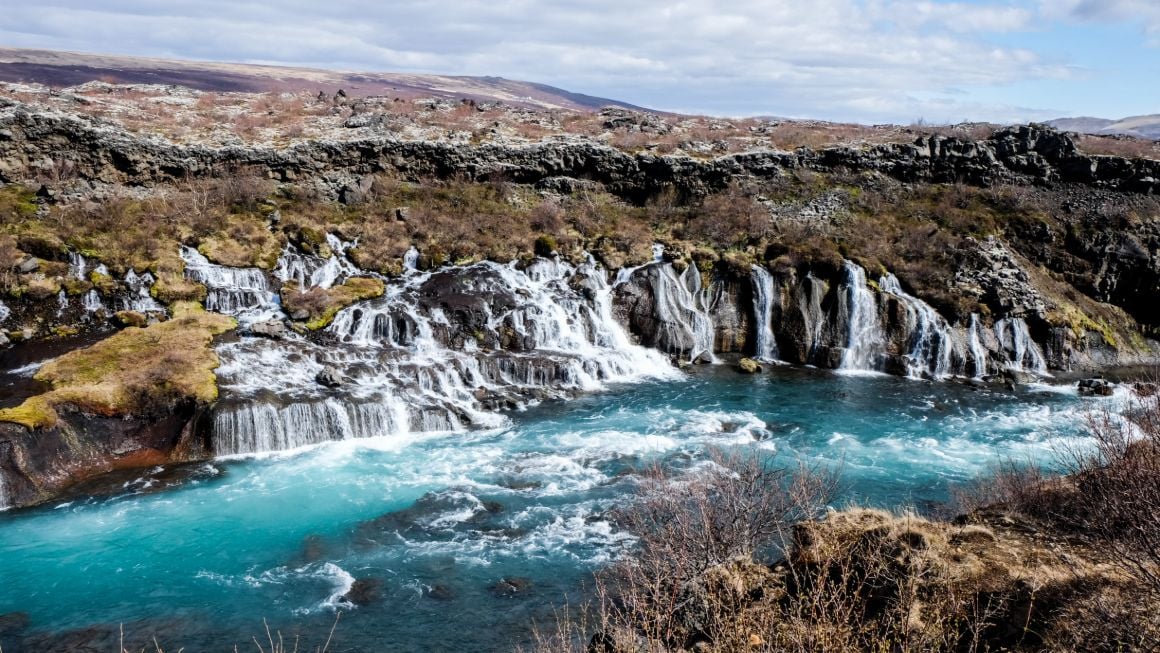
Whale-watching is best enjoyed between April and October – this is the peak season for travel, so make sure to plan and book well in advance. It is still possible to see whales outside of the summer season in certain regions, providing there aren’t any storm conditions. You’ll likely be given a thermal suit to protect you from the icy temperatures.
The northern lights are a popular reason for travel to Iceland. Usually, you can see these from around late September until March when the nights are darkest. Precipitation and cloud cover are not ideal for seeing the northern lights, so months where there’s less chance of cloud cover are ideal – October and November tend to be best.
The cheapest time to travel is during the winter months, outside of the Christmas and New Year period. Rates on Icelandic accommodation and flights are the cheapest at this time. However, if you want to balance costs with better weather for sightseeing, then aim for the shoulder seasons of spring and autumn.
Best Time to Go to Reykjavik
Reykjavik, Iceland’s vibrant capital city, is great to visit at any time of year. In the summer, the city gets around 21 hours of daylight and experiences the best weather. Maximum daytime highs reach into the high teens with precipitation at its lowest.
While summer offers great weather, it comes at a price. Accommodation in Reykjavik will be significantly more expensive at this time, tourist numbers are at their highest, and you can’t see the northern lights at this time of year. On the upside, there are plenty of festivals and celebrations during the summer months, and it’s a great time for whale-watching.
Autumn (September and October) is slightly cooler and the days start to get much shorter. However, prices on flights and hotels are much lower and the hordes of summer tourists have left. There’s a small chance you could see the aurora borealis on clear days, but if this is your primary reason for visiting, rather plan for a winter trip.
Rain and snow characterize the winter months. It’s dark and cold and perfect for seeing the Northern Lights. Winter in Reykjavik can be fun too! And you’ll easily be able to pick up a good deal on accommodation and flights, However, certain experiences might be unavailable due to poor weather conditions and the impact of this on the roads.
Spring is a mixed bag when it comes to weather, but it’s still much cheaper than peak season. The days are getting longer and warmer, which is great for sightseeing but not for seeing the Northern Lights .
Best Time to See the Northern Lights
The magical aurora borealis, or Northern lights, are a popular reason for travel to Iceland. The distances between cities here make it easier to avoid light pollution, and the winter months are dark, making it easier to see this incredible phenomenon.
Like most natural occurrences, predicting the visibility of the Northern Lights is not an exact science, so there is always a small chance you could miss it. Of course, there’s not much you can do to encourage a solar flare or solar wind to increase your chances of seeing the aurora, but you can plan your trip for a time when it’s more likely that you’ll see them.
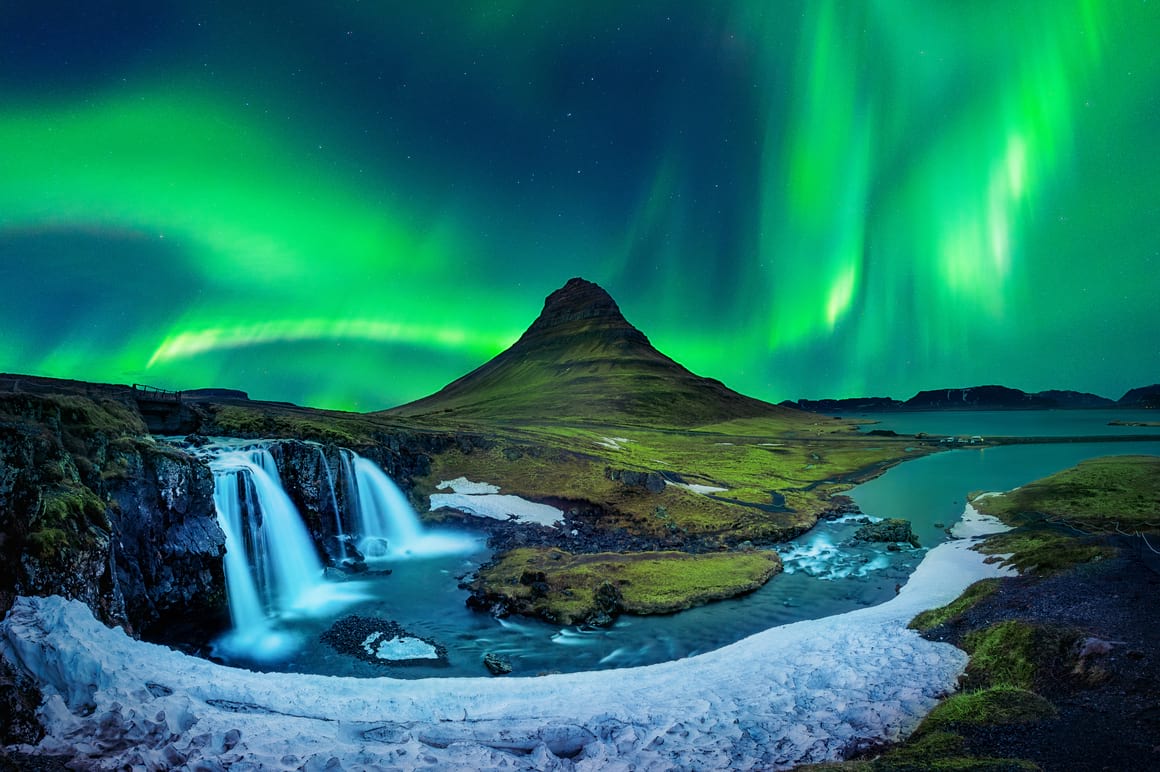
September to late March is commonly the time when it’s dark enough for the Northern Lights to be seen. Months where there’s less or no precipitation are preferable as cloud cover is the last thing you want. October and November offer dark nights and low chances for cloud cover, increasing your odds of seeing the Northern Lights.
February and March also offer good conditions for seeing the Northern Lights, but with a slightly increased chance of cloud cover.
Best Time to Do the Golden Circle
The Golden Circle is (as the name would suggest) a circular route that starts in Reykjavik and takes in some of Iceland’s most beautiful landscapes. It is a cornerstone for most Iceland tours . The route takes you to three of the country’s top attractions: Þingvellir National Park , Geysir geothermal area, and Gullfoss waterfall, and a whole host of extra little gems along the way.
The route can be done in one day, or you could take your time to explore some of the smaller, but no less fascinating locations in between. Scheduled group tours can have you back at your hotel before a full workday has passed, but a self-drive adventure at your own pace can be very rewarding.
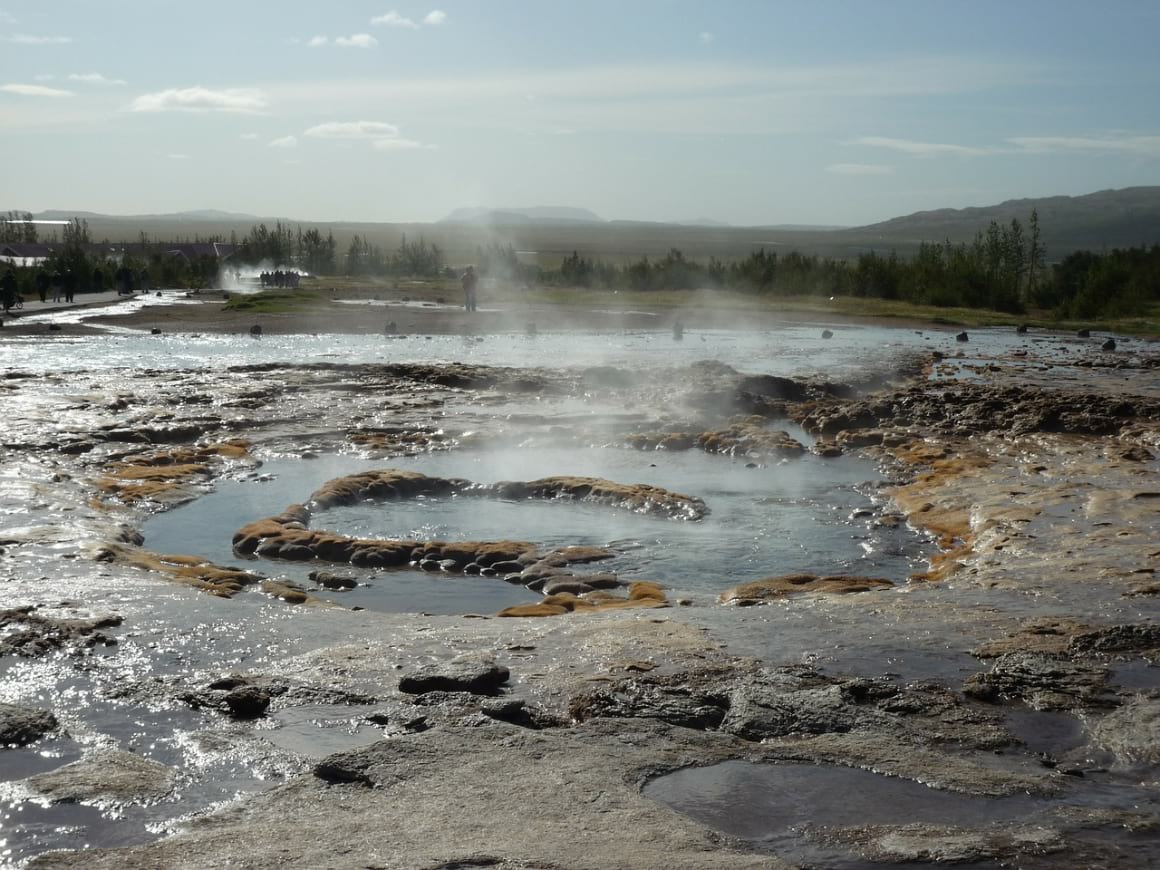
While the summer months offer the long days and mild weather ideal for sightseeing, it does come with the pitfalls of coach-loads of other tourists. If you’re doing a self-drive, accommodation along the way can get pricey at this time of year.
Of course, doing the Golden Circle in winter will offer a completely different perspective on the landscape. It will be cold, but it does mean you could be rewarded with sights of the Northern Lights as well. Gullfoss waterfall will be frozen and hauntingly beautiful at this time.
Best Time for Sightseeing in Iceland
The long daylight hours and mild weather of summer make it a great time to enjoy sightseeing. So great, that that’s when everyone does it. This means you’ll likely have to endure long waits at major attractions, straining to see past big crowds and the typical elevated pricing of high season.
Traveling in May or September, the months immediately before and after high season, offer the best weather for heading out to the many sights, while simultaneously avoiding the crowds and costs of peak season. While the days are shorter than in high summer, there’s still plenty of daylight to enjoy your sightseeing. Any earlier than May or later than September can see the weather becoming more variable, and the days very much shorter.
Winter is significantly cheaper for a visit to Iceland, however, aside from the icy temperatures, the snow and rain can make some roads impassable, meaning some sight will be inaccessible. The days are also very short, offering only around four or five hours of daylight to get your sightseeing in.

Wanna know how to pack like a pro? Well for a start you need the right gear….
These are packing cubes for the globetrotters and compression sacks for the real adventurers – these babies are a traveller’s best kept secret. They organise yo’ packing and minimise volume too so you can pack MORE.
Or, y’know… you can stick to just chucking it all in your backpack…
Cheapest Time to Go to Iceland
Winter, outside of the Christmas and New Year holiday period is the cheapest time to visit Iceland. This time of year is characterized by intense cold, dark days with only a few hours of daylight, and in times of bad weather, inaccessible roads in some places.
The shoulder seasons of spring and autumn offer a happy compromise between the lovely weather of summer and the low costs of winter. During these shoulder seasons, you can still enjoy good weather and a crowd-free experience.
Another benefit of travel outside of peak season is that you have the option to hold out for last-minute offers which can further save you on accommodation and flights.
If you are trying to save a few quid when visiting Iceland, check out the pod hostels in Reykjavik .
Busiest Time to Visit Iceland
Despite its long and dark winters, Iceland is a rewarding destination all year round and attracts tourists throughout the year. Of course, certain times are busier than others, so it’s always best to have all the facts when it comes to choosing the best time to visit Iceland.
The busiest tourist season is during the summer between May and September. These months offer the warmest weather, with daytime temperatures in the low 20s, and in some places almost 21 hours of daylight.
The long days and mild weather are ideal for sightseeing, whale-watching, and hiking. The Northern Lights are not visible during the summer months.
The winter months are the quietest time to visit Iceland, with the exception of the Christmas and New Year holiday period when we see a brief return to peak conditions with more tourists and higher pricing.
The shoulder seasons of spring and autumn are busier than the winter months in terms of tourist numbers but not as crowded as the peak summer season.
Weather in Iceland
Iceland has four very distinct seasons, although the weather at any time can be variable and unpredictable.
The west of the country benefits greatly from the warm Gulf Stream current that flows from the Caribbean. When this warm air meets the Arctic air from the north, things can get very temperamental.
There’s a saying in Iceland, ‘if you don’t like the weather, wait five minutes,’ and these swirling competing air masses are to blame for this. In the winter, this can lead to windy, stormy weather.
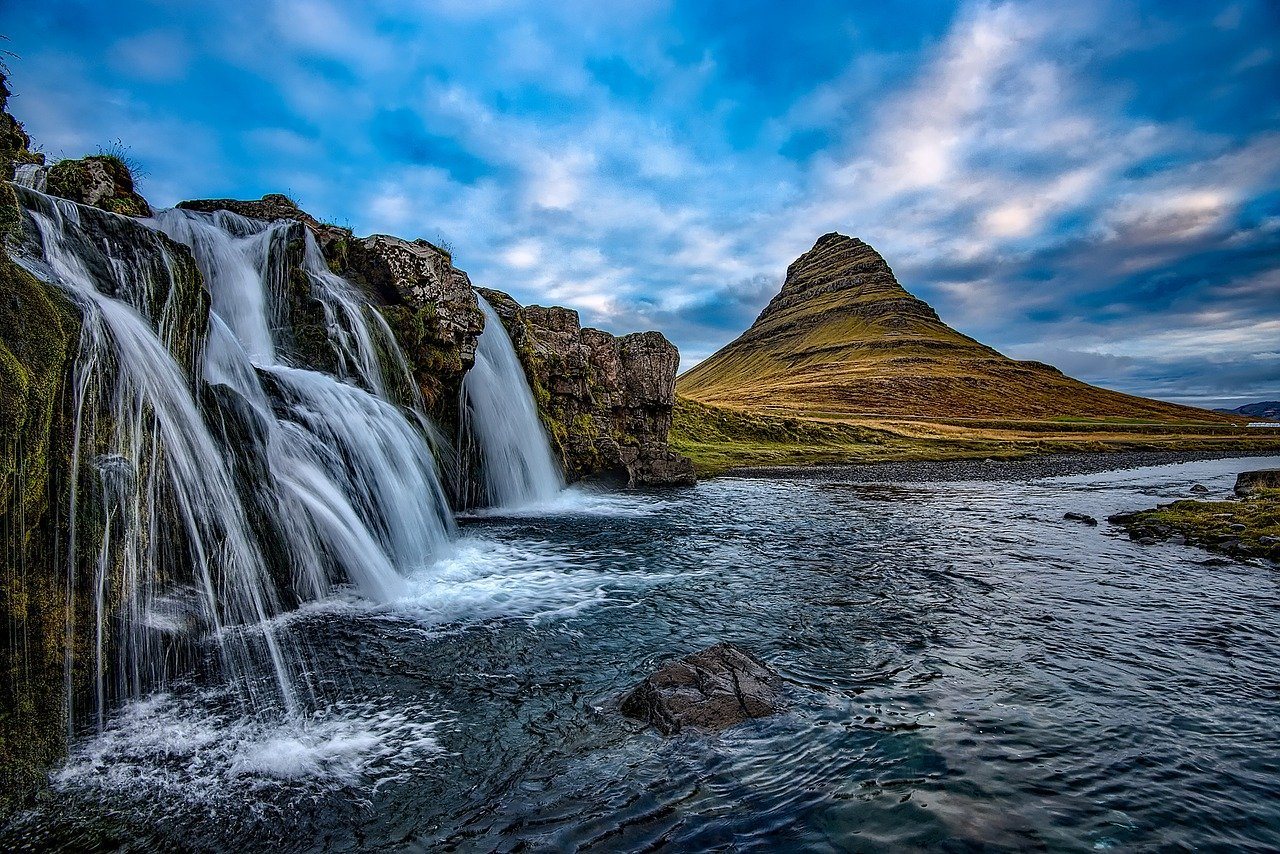
Summer in Iceland is characterized by long daylight hours and mild temperatures. Days rarely reach temperatures exceeding the low-20s, and while it’s mostly sunny and bright, it can also turn misty and rainy at the drop of a hat.
Winters are cold in Iceland, with frequent snow and rain. It’s dark, with only a few hours of daylight, and high temperatures rarely break into the double digits (Celsius). Stormy weather can cause problems with travel as some roads may become impassable.
Interestingly, although Iceland is located further north than most of Europe, the United States and parts of Canada, its winters aren’t as cold as, say, New York or even Russia. The warm Gulf Stream ensures that the country doesn’t quite live up to its name as much as we would expect.

Where is the Best Weather in Iceland?
The southern coastal region of Iceland is generally characterized by mild summers and cool winters which don’t often get too cold. The influence of the warm ocean currents causes an overall milder climate. The differences between summer and winter are not extreme, and rain can be expected at any time of year.
Further inland and in the higher elevations, the climate is much cooler. Summer peak temperatures rarely break into the teens (Celsius) and the winters are much colder than the southern coastal regions.
The northern regions of the country tend to exhibit cooler temperatures overall, with maximum daytime highs in winter hovering at around 10°C – significantly colder than in the south, which averages 0°C.

Stash your cash safely with this money belt. It will keep your valuables safely concealed, no matter where you go.
It looks exactly like a normal belt except for a SECRET interior pocket perfectly designed to hide a wad of cash, a passport photocopy or anything else you may wish to hide. Never get caught with your pants down again! (Unless you want to…)
Festivals in Iceland
Iceland celebrates many festivals annually, from ancient Viking traditions and religious observances to more contemporary celebrations. The population of Iceland may be small, but its capacity for celebration is large.
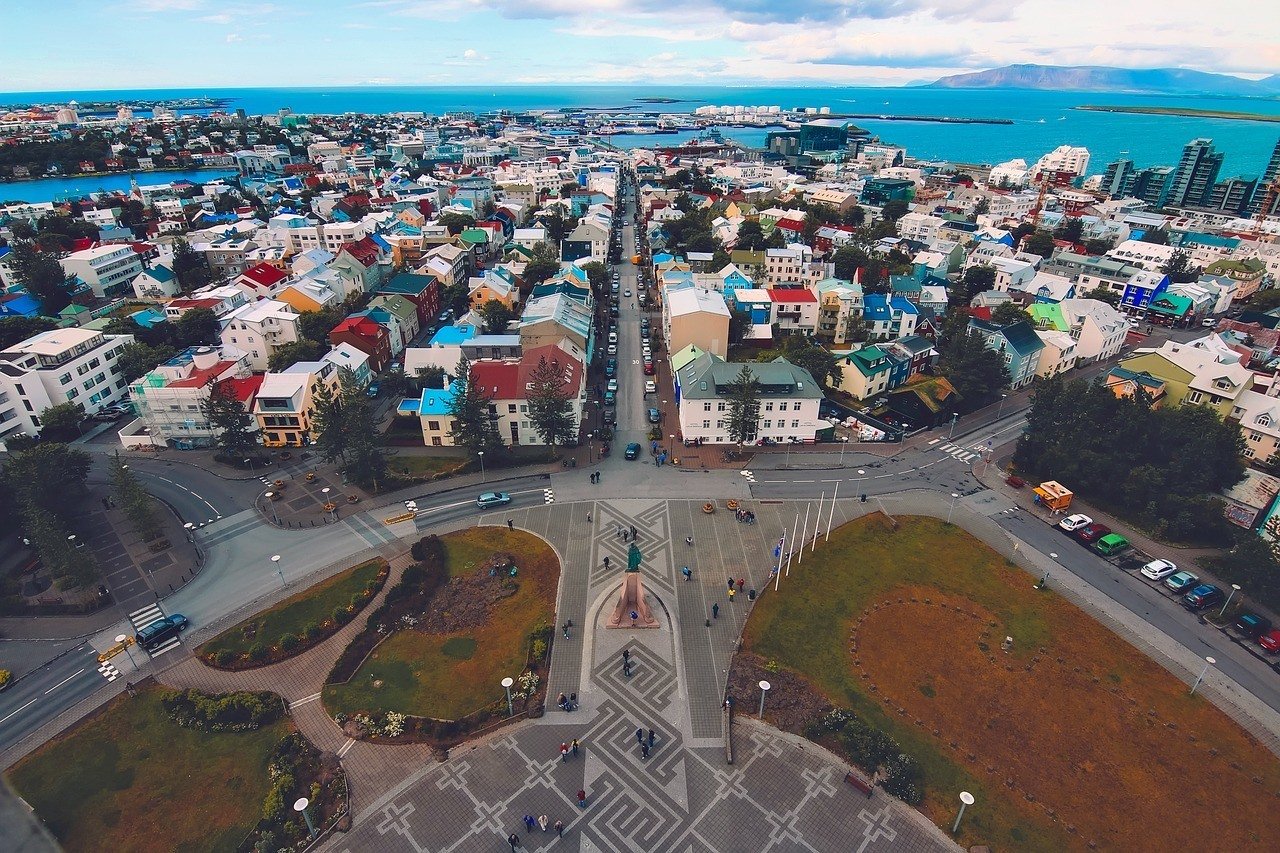
A slightly modernized Viking tradition featuring loads of singing and dancing and eating. The gastronomically adventurous and strong of stomach can try traditional delicacies like fermented shark, sheep’s head, and pickled ram testicles, and wash it down with a potent shot of brennivín – a schnapps-like spirit nicknamed the ‘Black Death’.
- Winter Lights Festival:
Hosted annually in February, the lights festival originated as a way to brighten up the darkness of the long winter months. Reykjavik is lit up with spectacular light installations, landmarks are illuminated, and various performances and shows.
Over the four days of the festival, you can also enjoy Pool Night and Museum Night – extended opening hours and free admission at the city’s pools and museums.
While not technically a festival or a celebration, the arrival of these shy, goofy-looking birds is worth taking note of. The puffins arrive on the shores in impressive numbers (over 10 million birds) in the spring for their breeding season, departing again by mid-August. Iceland is the breeding home for over 60 percent of the world’s Atlantic puffins, with colonies located all over the country.
The best time to see and photograph them is in late summer.
- International Viking Festival :
A celebration of the country’s Viking heritage, this is the oldest and biggest festival of its kind, held annually at Viking Village in Hafnarfjörður.
Five days of staged battles, dances, and story-telling offer visitors a glimpse into traditional Viking life. Visitors can learn to use traditional weapons like spears and axes, learn wood carving techniques, and purchase a variety of handmade goods from the market.
- Frostbiter:
Icelandic folklore is filled with tales of monsters and supernatural creatures. These dark tales are likely a result of the deep, dark winters, volcanic landscapes, and dramatic scenery of the country.
This penchant for dark themes has birthed an annual horror film festival celebrating these macabre, strange, and downright terrifying movies.
Horror film fans can head to Akranes, a small town north of Rejkyavik, for the Iceland Horror Film Festival which celebrates both local and international horror films.
Christmas is a special time to be in Iceland. From traditional Christmas concerts, festive markets, and twinkling lights that cut through the winter darkness, the country is transformed into a winter wonderland.
Any Christmas in Iceland is virtually guaranteed to be a white Christmas, and the chances increase the further north you travel.
If you’re still in any doubt as to the best time to visit Iceland for the experience you’ve been dreaming of, take a look at our month-by-month guide.
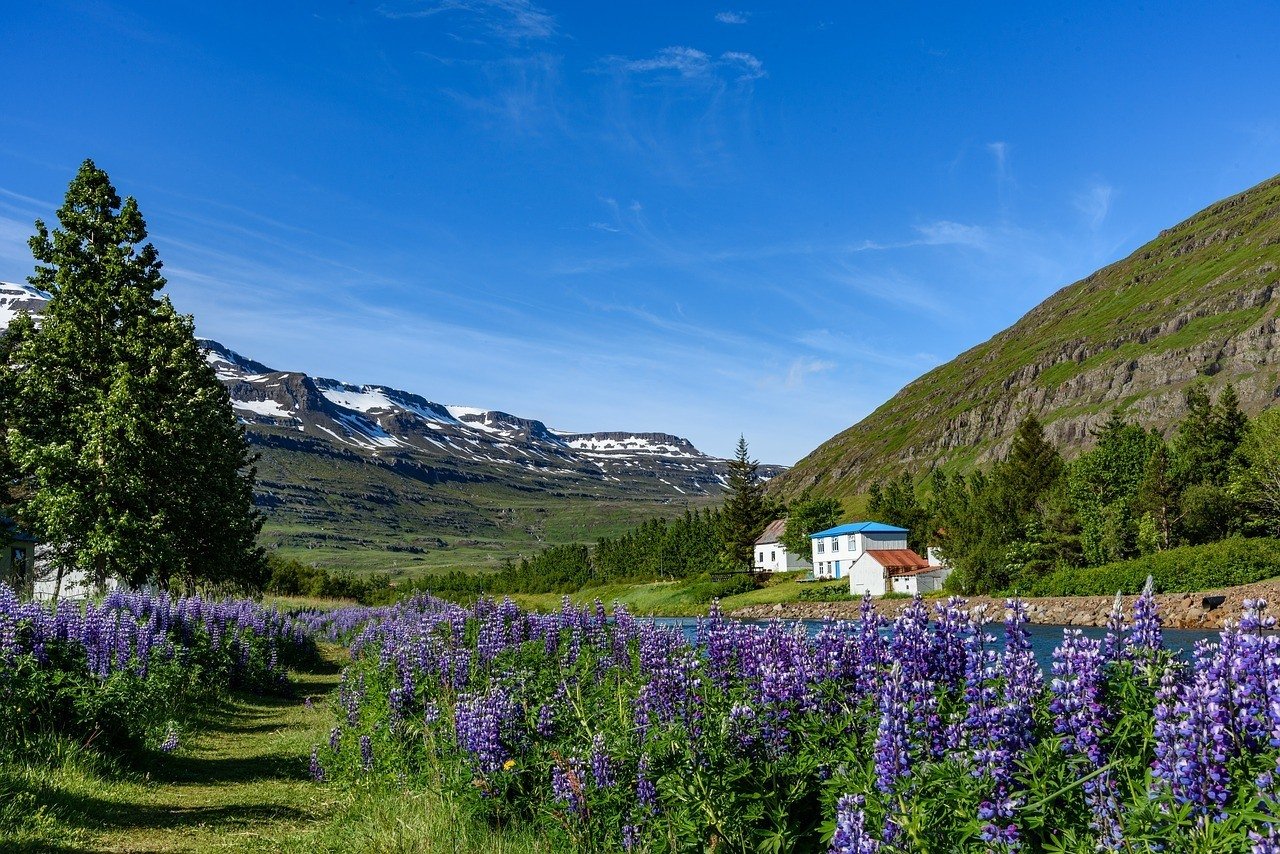
We’ve gathered all the details for each month of the year to help you find the ideal balance of costs, crowds, and climate.
January in Iceland
January in Iceland is cold and dark . Average high temperatures hover around 2°C and winds often reach gale force, making it feel colder than it is. There’s a good chance of rain and snow as well.
It’s very much low season, so definitely the cheapest time to visit Iceland , and there aren’t too many other tourists to contend with at tourist attractions. However, the days are short and offer only a few hours of daylight for sightseeing. Certain roads and attractions are likely to be closed or inaccessible due to weather conditions.
February in Iceland
It isn’t much warmer in February , but the chance of rain and snow decreases. The days are getting longer so there’s more time for sightseeing. Most of the roads should be accessible by now unless there’s a bad storm.
You’ll still benefit from low season conditions : sightseeing is still pleasantly crowd-free and prices are low.
March in Iceland
March is still cold with occasional rainy days . Snow isn’t likely unless you’re headed to the higher elevations. The days are getting significantly longer now, and there’s more daylight than darkness now.
There are few tourists around so sightseeing is still relatively uncrowded. This is a great time for winter sports in the mountains as there’s far more daylight to enjoy the slopes.
April in Iceland
This is the unofficial start of the summer season in Iceland. As the snow melts, the landscape is blanketed in greenery, and flocks of migratory birds arrive. While it’s still chilly with maximum temperatures only hitting the single digits (Celsius), there’s significantly less rainfall and much longer days .
Tourist numbers start to increase from April, but it’s still not peak season so costs and crowds are manageable.
May in Iceland
May is the best time to visit Iceland if you’re wanting a good balance between crowds, costs, and climate. The days are lovely and long, if a little chilly, there are fewer tourists, and prices are still low .
Temperatures are still fairly low, with the average maximum rarely peaking over 10°C. And like any time in Iceland, the weather has the potential to be erratic. Snow is unlikely unless you’re headed to the mountains.
June in Iceland
It’s now feeling a lot more like summer. Average high temperatures can get as high as 20°C but usually hover around the low-teens. You can expect bright, sunny days for the most part, with the longest days of the year.
With the mild weather come the crowds and peak season pricing . Anyone wishing to visit in high season should book well in advance.
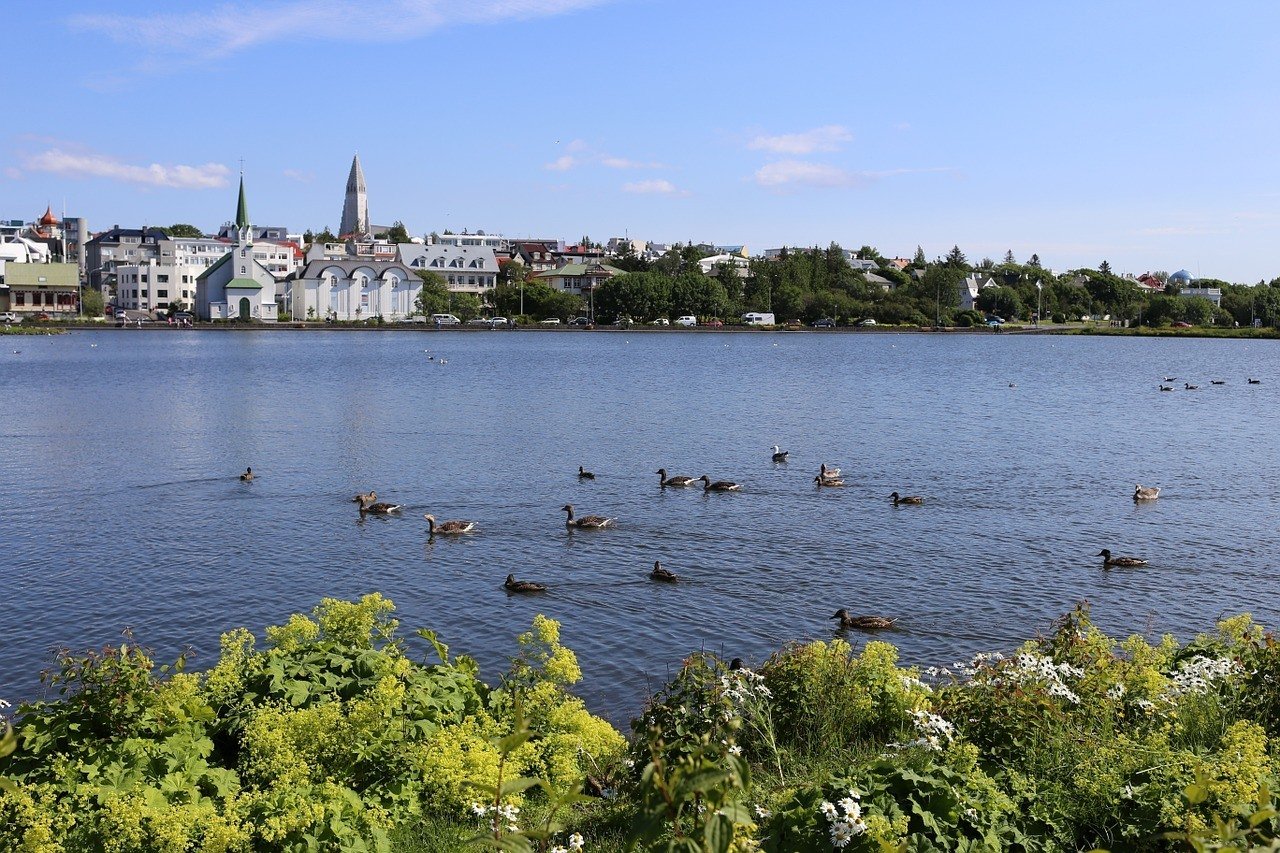
July in Iceland
Like June, July offers long sunny days and mild temperatures that attract large numbers of tourists. Average daytime temperatures creep closer to the mid-teens, but can sometimes get much higher. You may experience light rain on occasion.
This is one of the most popular times to visit Iceland , so expect busy attractions, crowds of tourists, and elevated pricing. If you’re visiting at this time, there are plenty of outdoor festivals and celebrations to attend.
August in Iceland
It’s still fairly warm in August, with daytime highs in the low teens , but the temperatures start to decline noticeably as the month progresses. There’s a slightly higher chance of rain, and days are getting noticeably shorter too.
It’s still a great time to travel to Iceland in terms of weather, but you may still encounter large numbers of tourists and higher pricing.
September in Iceland
The days shorten significantly in September in the lead-up to winter. It’s rainier at this time of year and the temperatures are cool , with an average maximum of around 10°C. The first sightings of the northern lights are possible now, although not guaranteed.
If you’re visiting at this time, you can enjoy the crowd-free conditions and the lower pricing that follows the peak season.
October in Iceland
Weather conditions become much more wintery in October. While it’s technically only autumn, the average maximum temperatures drop into the single digits, the days are short, and rain is common.
Conditions are still good for sightseeing and the weather hasn’t yet impacted the conditions of the roads. You’ll also benefit from fewer crowds and off-peak pricing . The northern lights become much easier to see from October onwards.
November in Iceland
Temperatures continue to drop along with the number of daylight hours. There are only a few hours of daylight to enjoy, so you’ll need to plan your time well. Light rain is common, and if you’re heading further north, your chances for snow increase. Some attractions and roads are impacted by the weather and may not be operating.
Tourist numbers are low at this time, making sightseeing pleasant and stress-free. You may be able to pick up some great deals on accommodation during November.
December in Iceland
The cities transform into festive winter wonderlands , with twinkling lights and festive markets brightening up the winter darkness. Snow is common at this time as is rain, and average daytime temperatures hover around 4°C.
There’s a small spike in tourism around Christmas, but if you book in advance, you’re still likely to pick up a good deal on accommodation.

A new country, a new contract, a new piece of plastic – booooring. Instead, buy an eSIM!
An eSIM works just like an app: you buy it, you download it, and BOOM! You’re connected the minute you land. It’s that easy.
Is your phone eSIM ready? Read about how e-Sims work or click below to see one of the top eSIM providers on the market and ditch the plastic .
When is the Best Time to Go to the Golden Circle?
The Golden Circle route can be done at most times of the year. May and September are the best times, as they offer pleasant weather and fewer tourists.
When is the Rainy Season in Iceland?
The weather in Iceland is notoriously unpredictable and rain can be expected at any time in the year. Most of the rain falls over the winter months between October and February.
When is the Coldest Month in Iceland?
January and February are the coldest months in Iceland. The average maximum temperature is around 2°C, and rainfall and snow are frequent.
When is the Worst Time to Visit Iceland?
Iceland’s short summer occurs between June and August. This is when large numbers of tourists flock to Iceland to enjoy the sights in the mild weather.
Don’t Forget your Iceland Travel Insurance
ALWAYS sort out your backpacker insurance before your trip. There’s plenty to choose from in that department, but a good place to start is Safety Wing .
They offer month-to-month payments, no lock-in contracts, and require absolutely no itineraries: that’s the exact kind of insurance long-term travellers and digital nomads need.

SafetyWing is cheap, easy, and admin-free: just sign up lickety-split so you can get back to it!
Click the button below to learn more about SafetyWing’s setup or read our insider review for the full tasty scoop.
Iceland, the Land of Fire and Ice, is a land of contrasts and extremes. Whether you choose to visit in the height of summer or the very depths of winter, each experience will yield a unique perspective of this fascinating island.
Choosing the best time to visit Iceland will depend largely on what experiences you wish to have. It all comes down to striking a balance between the weather conditions, the tourist numbers, and seasonal pricing.
If you’re planning a visit in the summer – you’ll be treated to long sunny days, but it’s essential to book well in advance. If you’re hoping to go off the beaten track and explore outside of the peak season, you might want to hold out for a last-minute deal.
Either way, there’s plenty to experience in Iceland. And when you’ve done it all? Come back and do it all again in a different season for a completely new perspective.
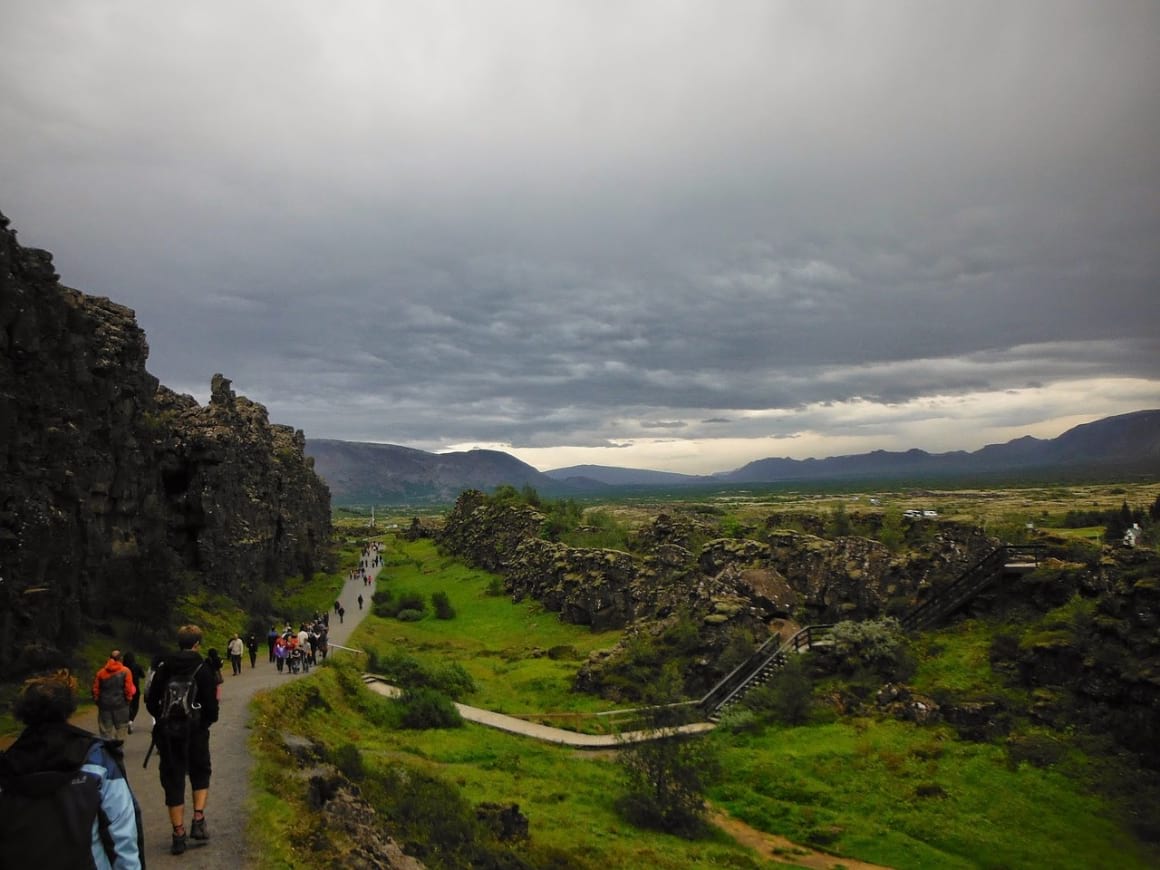
- Let’s get you ready for your next adventure with our backpacking Iceland guide .
- Check out the best hostels in Iceland to kickstart your adventure.
- Know where to stay in Reykjavik BEFORE you get there… trust me on this one.
- With the best international SIM card you can stay connected, always.
- Seeking a once-in-a-lifetime experience? Explore the best places to see the northern lights .
- Explore some of the best waterfalls in Iceland to experience something a lil’ different.
- Plenty of backpackers – myself included – make a stop at Iceland’s Blue Lagoon at the end of their Iceland adventure.
- Expand your horizons and explore the best winter destinations in Europe .

And for transparency’s sake, please know that some of the links in our content are affiliate links . That means that if you book your accommodation, buy your gear, or sort your insurance through our link, we earn a small commission (at no extra cost to you). That said, we only link to the gear we trust and never recommend services we don’t believe are up to scratch. Again, thank you!

Christina Grayt

Share or save this post

My husband and I will be in Reykjavik from August 16 to August 18th. We are very interested in taking a Golden Circle small group tour on August 17th. How do I find such a day tour?
Ask at the local tourist information centre, check online, or ask at your accommodation. There will be more than a few tour companies advertising their jaunts.
Leave a Reply Cancel reply
Your email address will not be published. Required fields are marked *
Save my name, email, and website in this browser for the next time I comment.
Notify me of followup comments via e-mail.
- Search Please fill out this field.
- Manage Your Subscription
- Give a Gift Subscription
- Sweepstakes
- Travel Tips
These Are the Best Times to Visit Iceland
Here are the best times to visit Iceland for ideal weather, fewer crowds, and more.
:max_bytes(150000):strip_icc():format(webp)/Brandon-Presser-97a4675f1bb3487b88f06e5e2234eac6.jpeg)
Elizabeth Rhodes is a special projects editor at Travel + Leisure , covering everything from luxury hotels to theme parks to must-pack travel products. Originally from South Carolina, Elizabeth moved to New York City from London, where she started her career as a travel blogger and writer.
:max_bytes(150000):strip_icc():format(webp)/elizabeth-rhodes-25083778bc654f69b30ce8417affc82c.jpg)
Over the last decade, Iceland has become one of Europe's "it" destinations thanks to its ethereal — and highly photogenic — landscapes featuring ancient glaciers and rugged fjords.
Before you book your flight to this popular island nation, you'll want to think about everything you want to see and do on your trip because the time of year can determine what's available. Some attractions, like Iceland's famous hot springs , are open all year, while natural phenomena like the northern lights and midnight sun are best viewed during specific months. Here's a breakdown of the tourist seasons in Iceland:
- High Seasons: June to August and late December
- Shoulder Seasons: September to October and May
- Low Season: November to April, excluding holidays
Read on to learn about the best time to visit Iceland for whale watching, northern lights spotting, and more.
Irjaliina Paavonpera/Travel + Leisure
Best Times to Visit Iceland for Smaller Crowds
The busiest months in Iceland are June, July, and August, when most natural attractions are open and easily accessible. Iceland can stay relatively warm through the first week of October, so planning a September visit can be ideal since most crowds have thinned as children return to school. May, too, provides ample daylight for sightseeing, warmer temperatures, and fewer crowds.
The off-season between November and April is ideal for those looking to escape the hordes of tourists, as long as you don't mind the dark (by mid-winter, expect only five or six hours of daylight). Though some roads are closed, it's a glorious time to enjoy hot springs, backcountry skiing, and tours by snowmobile or jeep. You'll also have a better chance of spotting the northern lights. Tourism tends to pick up again during the holiday season, so avoid December if you're looking for a crowd-free vacation.
Courtesy of Visit Iceland
Best Times to Visit Iceland for Good Weather
During the summer months — July and August — the temperature in Iceland hovers around 50 to 55 degrees Fahrenheit, making it a popular time to visit. And June, with its 24 hours of daylight, sees just about as many tourists as the peak of summer. But even during this season, rain and intense wind are not uncommon. The island's fickle climate often means you can experience all four seasons in a single day.
The weather remains pleasant in September, with temperatures between 43 and 52 degrees Fahrenheit. May is similar, but if you're keen on exploring some of the more remote hills and fjords, it might not be the best time to visit, as some roads remain closed while they thaw from winter's snowy cover. For serious hikers, the best time to visit Iceland is during the summer, when all the mountain roads and famous trails are open and accessible.
Best Times to Visit Iceland for Lower Prices
Getting to Iceland can be relatively affordable, especially compared to other European destinations. Travelers from the United States and Europe frequently find flight deals — keep an eye out for sales on Icelandair and low-cost airline Play to save even more on your journey.
Accommodations, tours, attractions, and meals can be pretty pricey throughout the year, but you might be able to save money by visiting during the off-season, which is typically late fall through early spring, excluding December. Summer is usually the most crowded and expensive time to visit.
Best Time to Visit Iceland for the Northern Lights
You'll need three essential factors to see the aurora borealis: darkness, clear conditions, and a surge in solar activity. The northern lights are often elusive and can easily be marred by transient clouds. To avoid disappointment, travelers should never plan their trip to Iceland solely for the northern lights because the island's weather is too capricious (statistically, there are more clear nights in Yellowknife, Canada , for example.) The best way to optimize your chances of seeing the northern lights in Iceland is by visiting from mid-October through March, when you have extended hours of darkness, and by getting out into the countryside to reduce ambient light pollution.
Best Time to Visit Iceland for Whale Watching
According to Icelandic marine biologist Edda Elísabet Magnúsdóttir, the peak months to go whale watching in Iceland are June and July. During the summer, Reykjavík sees higher numbers of minke whales and dolphins, while orcas congregate in West Iceland along the Snaefellsnes peninsula during the first half of the year.
In northern Iceland, you'll have a wider window to enjoy visits from humpbacks, minkes, and dolphins, which ply the Atlantic from May to August; a few humpbacks even stick around until the end of the year. Blue whales pass through in the summer, too. For best results, head to the charming small town of Húsavík , where you can spot more than 20 species of whales on boat tours that leave from the harbor.
Best Time to Visit Iceland's Hot Springs
Hot springs are intrinsic to Icelandic culture for social as well as wellness benefits. Reykjavík's public pools are open year-round (and are especially invigorating during the dead of winter), but Iceland also has hundreds of hidden "hot pots" that tap directly into the geothermal activity under its lava-ridden surface.
Expert Icelandic mountaineer and cofounder of Midgard Adventure , Sigurdur Bjarni Sveinsson, offers the following advice for hot water hunters: "Check them out during September or, even better, the first half of October, when they're all still accessible by mountain road, but the crowds of tourists have significantly died down."
For travelers who want to visit the Blue Lagoon , the most famous geothermal spa, the best time to visit is during the off and shoulder seasons, when crowds are thinner.
Worst Time to Visit Iceland
Thanks to Iceland's stunning landscapes and seasonal natural phenomena, there's really no bad time to visit. Northern lights seekers flock to the country during the darker winter months, while visitors chasing more daylight opt for summer. Of course, those traveling in the spring and fall can take advantage of more moderate weather and daylight, so the best time to visit Iceland depends on what you want to see and do during your trip.
That said, the warmest months of the year are easily the worst time to visit if you're hoping to avoid the onslaught of tourists. July and August see the highest number of travelers, with big-ticket attractions like the Blue Lagoon, Golden Circle, South Coast, and Jökulsárlón being particularly overrun. If you're planning to visit during that time, consider exploring more remote corners of the island like the Westfjords or East Iceland, which have their own cache of fjords, vistas, and waterfalls that are just as impressive as the natural attractions surrounding the capital — if not more.
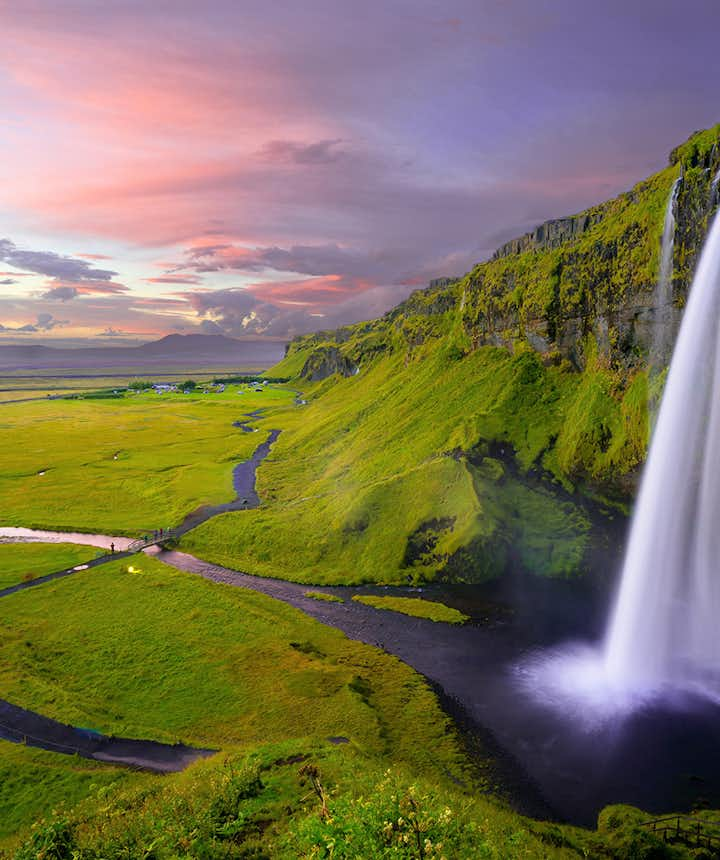
When Is the Best Time to Visit Iceland? - A Comprehensive Guide for Every Month & Season

What Is the Best Time of Year to Visit Iceland?
Iceland in spring, iceland in summer, iceland in fall, iceland in winter, when to visit iceland for seasonal activities, best time to see the northern lights in iceland, best time to see the midnight sun in iceland, best time to go whale watching in iceland, best time to go ice caving in iceland, best time to take a road trip in iceland, best time to visit the blue lagoon, best time to go camping in iceland, best time to visit hot springs in iceland, best time to go river rafting in iceland, best time to go birdwatching in iceland, the travel seasons in iceland, peak season in iceland, shoulder season in iceland, low season in iceland, weather & daylight hours in iceland, spring weather & daylight hours in iceland, summer weather & daylight hours in iceland, autumn weather & daylight hours in iceland, winter weather & daylight hours in iceland, the best month to visit iceland, iceland in january, iceland in february, iceland in march, iceland in april, iceland in may, iceland in june, iceland in july, iceland in august, iceland in september, iceland in october, iceland in november, iceland in december, faqs about the best time to go to iceland, can i visit iceland in winter, are the northern lights visible during the summer in iceland, is it possible to visit the golden circle year-round, what should i wear when visiting iceland in winter, what should i wear when visiting iceland in summer, can i rent a car and drive in iceland any time of the year.

By understanding how each season offers distinct experiences, you'll be better equipped to plan your ideal Icelandic adventure that's tailored to your preferences and priorities. As Iceland is located in the far northern hemisphere, right at the edge of the Arctic Circle , the differences between seasons are quite dramatic.
The best time of year to visit Iceland, therefore, depends on what you most want to do. Whether you're looking to go whale watching , head to a glacier to explore an ice cave or visit the Westfjords , the time of year is key when it comes to planning your trip.
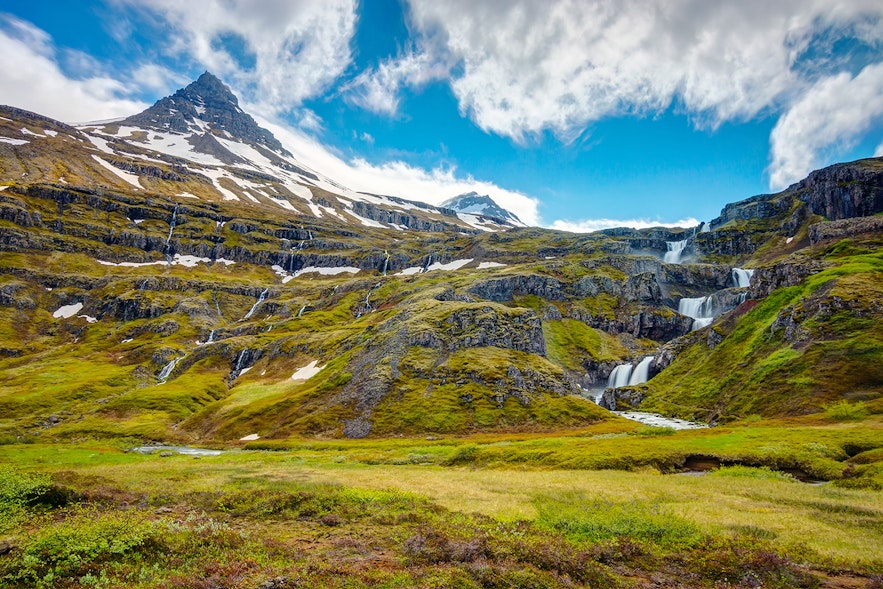
When wondering about the best time to travel to Iceland, first, you need to make a decision on what season works best for you. Iceland's four seasons differ in not only the weather but also the number of daylight hours. Each season has its characteristics and different things to do that may not be available in other seasons.

Additionally, spring is an ideal time for birdwatching enthusiasts, as migratory birds, including the charming puffin, return to nest along the rugged cliffs. It's also the last chance to see the northern lights before it gets too bright. Overall, spring provides a serene and picturesque setting for exploring Iceland.
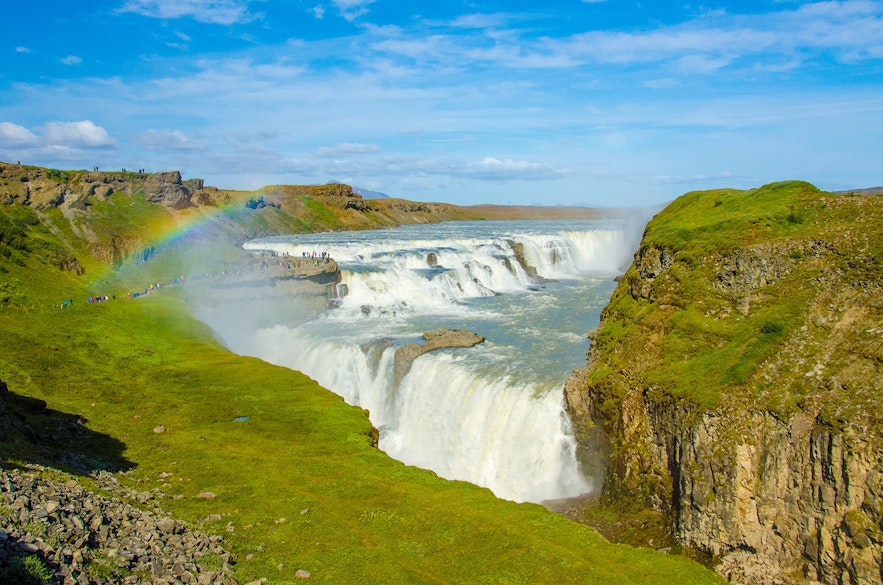
The warmer temperatures also make it a perfect season for outdoor activities such as horseback riding and going on hiking tours . Summer is the peak season for the number of travelers, so expect more crowds at popular attractions. However, the opportunity to go on tours of the Highlands and indulge in various festivals celebrating Iceland's culture and history makes it a truly memorable time to visit.
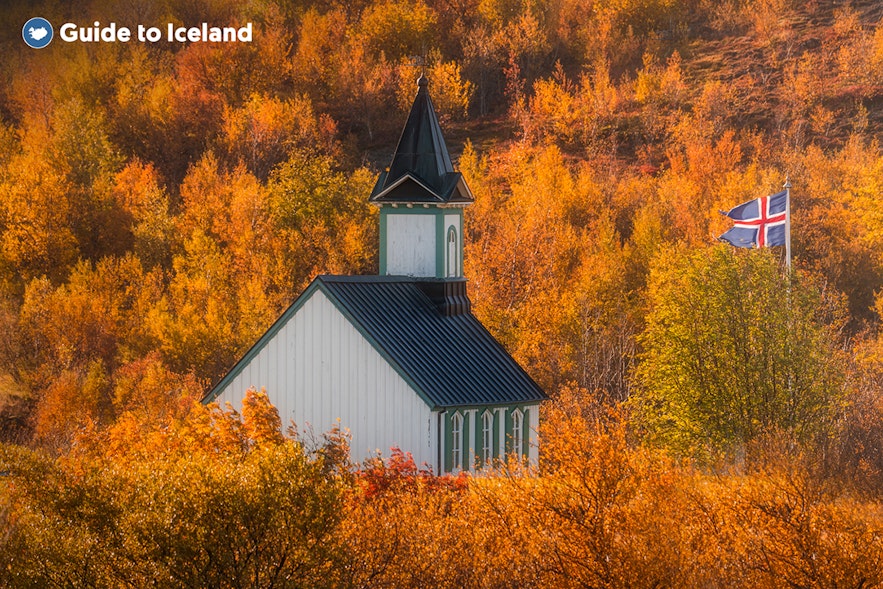
With cooler temperatures setting in, visitors can still enjoy outdoor pursuits such as hiking and exploring geothermal hot springs without the summer crowds. Fall also brings the return of darker skies, so the chance of seeing the elusive aurora borealis returns. Visiting Iceland in the fall promises a unique blend of natural beauty, space to roam, and opportunities for unforgettable experiences.
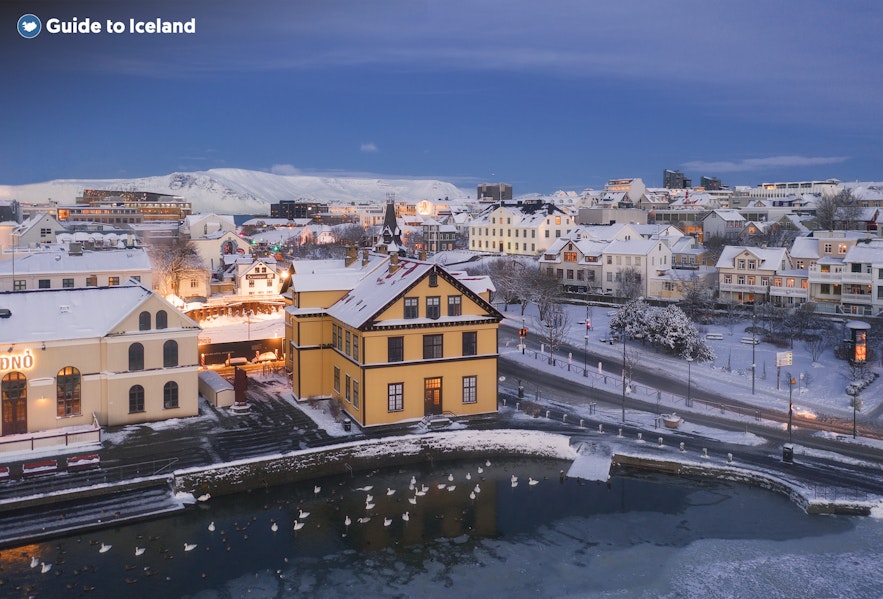
The long nights provide ample opportunity to chase the magical northern lights or even go on a northern lights cruise , while the festive atmosphere in towns around the country allows visitors to enjoy the local Christmas celebrations and the bombastic New Year's Eve. Although the weather can be unpredictable, visiting Iceland in winter offers a unique experience that highlights the country's enchanting allure.
- Learn more: New Year's Eve in Iceland
Because of the wide range of different activities and things to do in Iceland, it can be helpful to break down what activities are possible dependent on the time of year. Of course, there are plenty of things you can do any time of year, such as engaging in delicious food tours in the city or exploring the many waterfalls around the country (just wear layers in the winter!), but below are a few of the seasonal-dependent activities that might make or break when you'd want to visit Iceland.
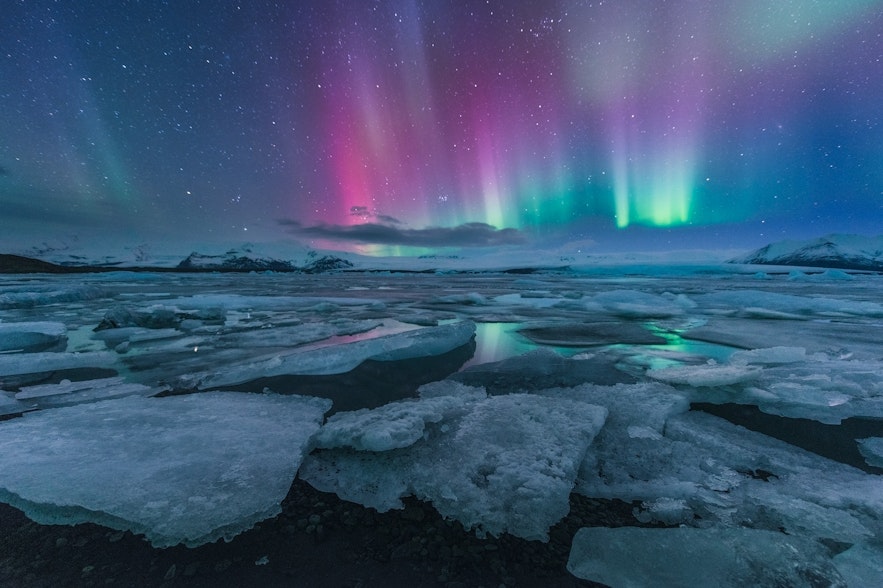
Keep in mind that while this mesmerizing phenomenon is largely dependent on solar activity and clear skies, it is also important to venture away from city lights to areas with less light pollution for the best viewing experience. Then cross your fingers and enjoy the show!
Top Northern Lights Tours & Holidays
2 day ice cave tour with south coast waterfalls & jokulsarlon glacier lagoon, 3-day northern lights tour of iceland’s golden circle & south coast with ice caving & glacier hiking, 8-day guided northern lights winter tour of the complete ring road of iceland.
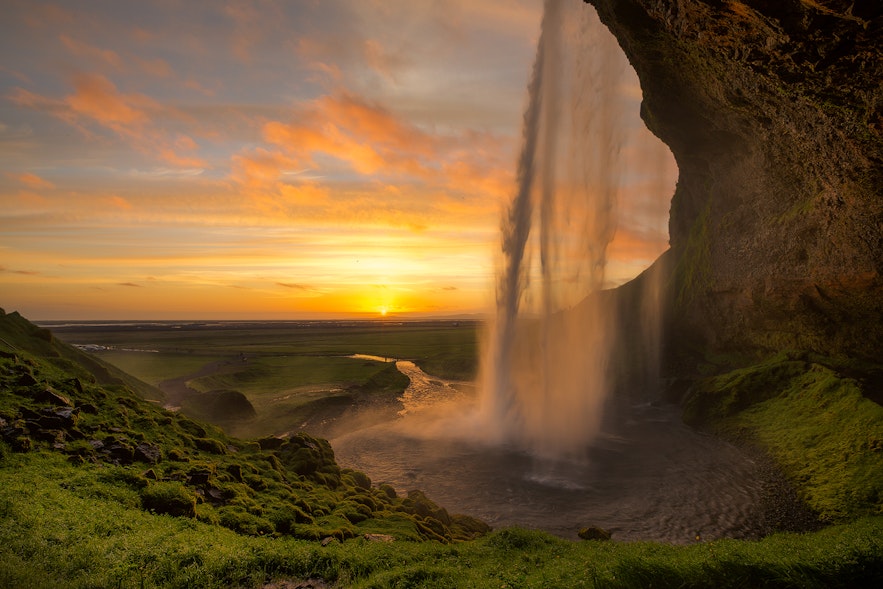
During this time, the sun barely dips below the horizon, and daylight extends into the night as the sky turns pink and purple during a long-lasting twilight period. This provides plenty of opportunities for late-night sightseeing, photography, and exciting midnight sun tours .
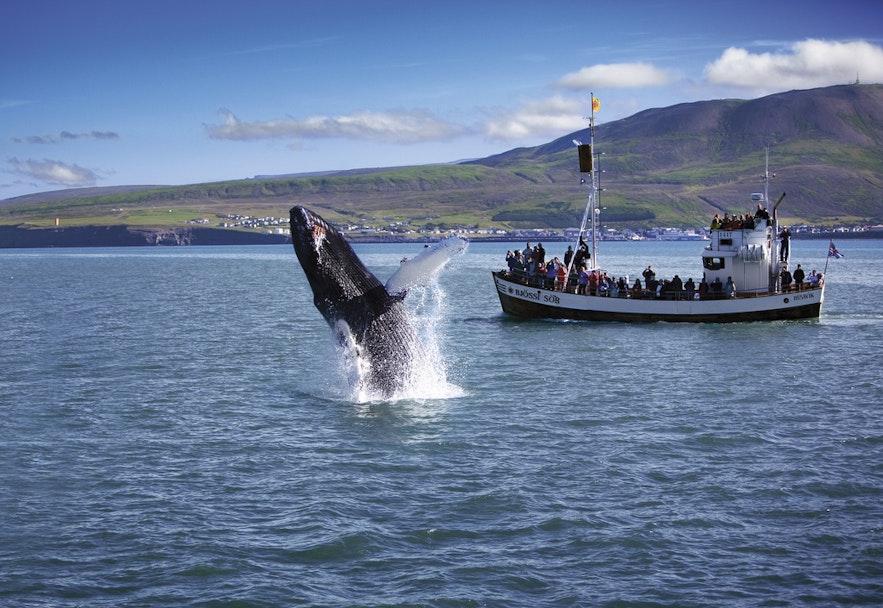
Photo from Original 3-Hour Whale Watching Adventure in Oak Boats
The best time to go whale watching in Iceland typically falls between April and October, with peak season occurring in the summer months of June, July, and August. During this period, the seas around Iceland become a feeding ground for multiple species of whales, resulting in a higher probability of sightings. Minke whales, humpback whales, and white-beaked dolphins are commonly sighted during these months.
However, orcas and dolphins are most commonly spotted during the winter months, specifically from February to March, when Breidafjordur bay becomes a feeding ground full of herring, which can be spotted on this Snaefellsnes whale-watching tour . You can also keep in mind that whale-watching tours are less crowded during the winter, which is another advantage.
- Learn more: The Best Guide to Whale Watching in Iceland
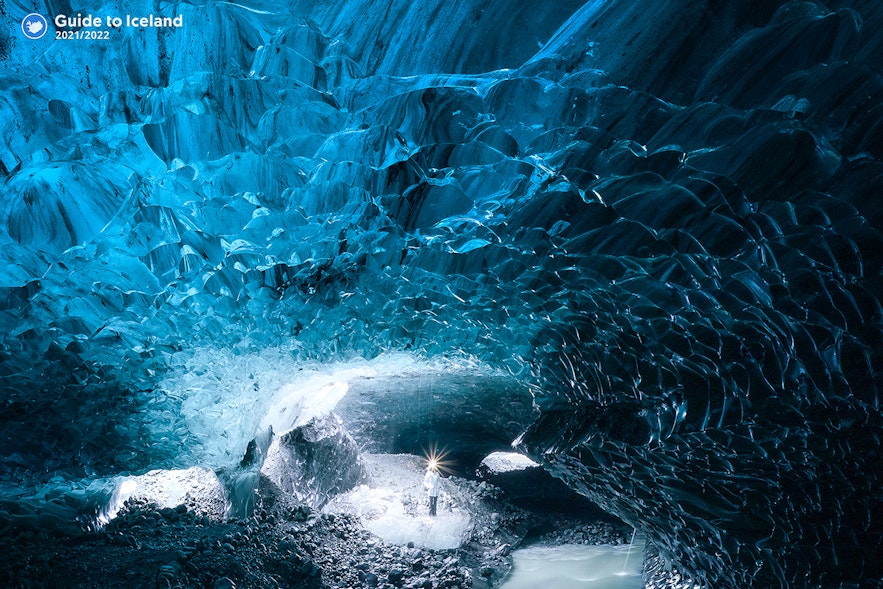
Photo from Best Ice Cave Tour in Vatnajokull Glacier
The optimal time for ice caving in Iceland is during the colder months, typically from November to March. During this period, the temperatures drop sufficiently to freeze the glacial ice caves, making them safe and stable to explore. That's when they're at their most spectacular, with the clear blue ice illuminated by the refracturing sunlight. It's important to note that ice caving should always be undertaken with a guide on professional ice cave tours .
During the summer, most ice caves become too unstable to be visited safely, with two exceptions! You can still visit the ice cave at Katla , near the town of Vik on Iceland's south coast. Additionally, you can visit the ice cave tunnel in Langjokull , which was carved into the glacier itself.
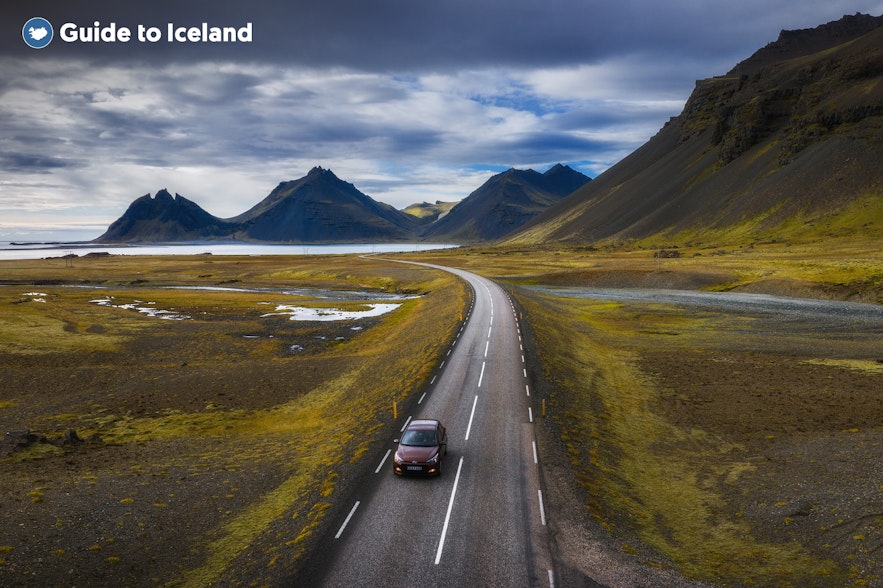
However, if viewing the northern lights is on your bucket list, consider a road trip between September and March when they are visible after sunset. Be mindful that winter driving can be challenging due to unpredictable weather and shorter days, and renting a 4x4 car is crucial to stay safe. Check out the many winter self-drive tours available, which are fully customized with extensive itineraries and pre-booked accommodations around the country.
Top Self Drive Tours in Iceland
Best ice cave tour in vatnajokull glacier starting from jokulsarlon glacier lagoon, 10-day self-drive tour of the complete ring road of iceland with top attractions & snaefellsnes, best 1-week summer self-drive tour of the ring road of iceland & golden circle.
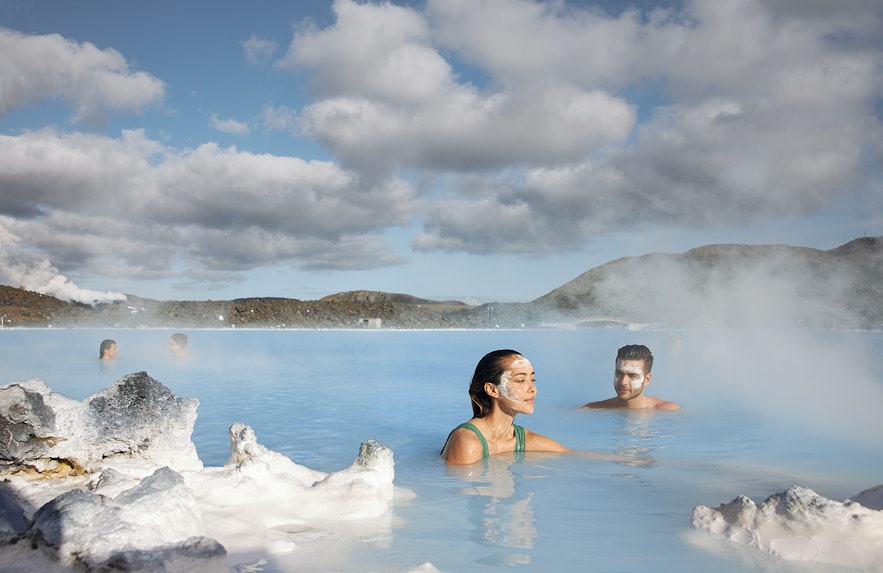
However, for those seeking to view the northern lights while relaxing in the warm waters, the best time to visit is during the winter months (September to March), although keep in mind that daylight is significantly shorter during this time. Regardless of the season, this warm lagoon often gets busy, so it's advisable to book your tickets to the Blue Lagoon well in advance and try to go early in the morning or later in the evening when it's less crowded. There's also a wide variety of Blue Lagoon tours that incorporate other activities with a visit to the famous geothermal spa.
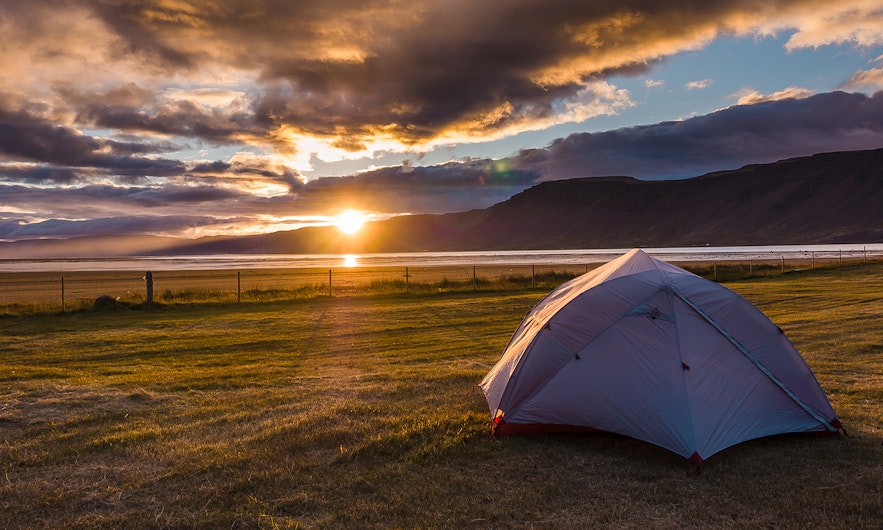
While camping in other seasons is possible, winter camping can be particularly challenging due to harsh weather conditions, limited daylight, and the closure of many campsites. Keep in mind that no matter the season, camping outside of designated camping sites is illegal, including parking rental campervans overnight.

Photo from Admission to Hvammsvik Hot Springs near Reykjavik
Hot springs in Iceland can be enjoyed throughout the year, each season offering its unique charm. During the summer months, from June to August, the milder weather and extended daylight hours allow for more flexible planning. Visiting during the midnight sun can add an extra layer of enchantment to your hot springs experience.
However, many people find the contrast of Iceland's chilly winter temperatures and the warm geothermal waters irresistible. There's also a chance to see the northern lights while you soak, creating a truly unique experience. Just remember that access to some remote hot springs can be more difficult in winter due to harsh conditions, so make sure to always check road conditions and weather before heading out.
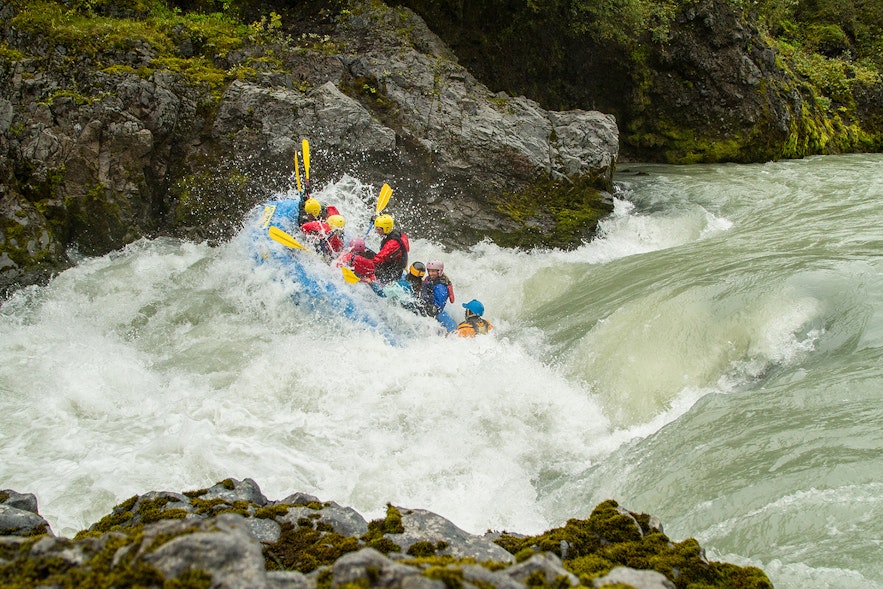
Photo from Whitewater Action in North Iceland
The ideal time for river rafting in Iceland typically falls within the summer months, from June to early September. That's when the weather is warmer and the snowmelt from the mountains feeds the rivers, creating thrilling white-water conditions ideal for rafting. If you're traveling with children, you could even embark on this 3-hour family-friendly river rafting tour in North Iceland .
Although the summer months are best, the season can start as early as May and extend into September, depending on weather conditions.
Top Rafting Tours
Family-friendly 3 hour whitewater river rafting tour in north iceland, whitewater action in north iceland, river rafting tour in north-iceland | west glacial river.
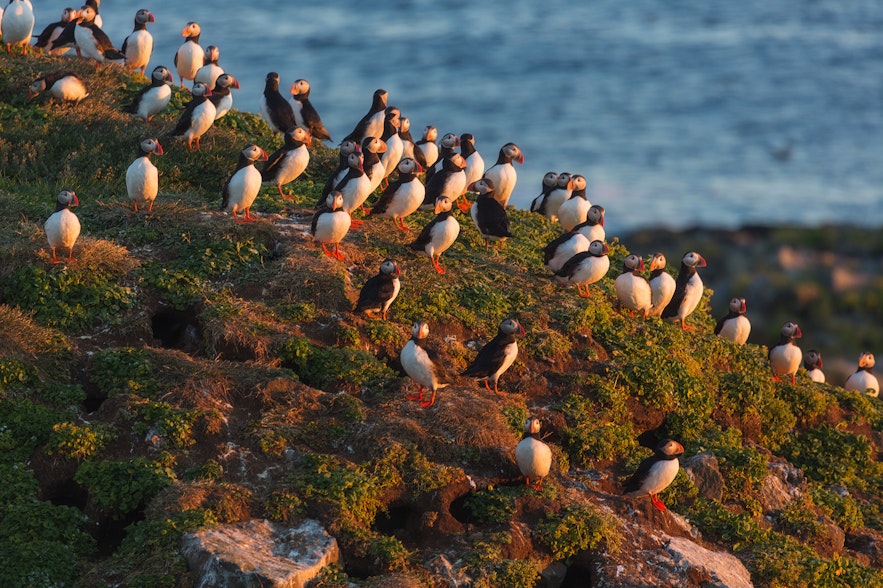
Also, with the summer's extended daylight hours, you have plenty of time to observe these feathered creatures in their natural habitat. Locations like the Latrabjarg cliffs in the Westfjords , Lake Myvatn in the north, and the Westman Islands are prime spots for birdwatching during this period. However, remember to respect the birds' nesting areas and observe from a safe distance to avoid causing any disturbance.
- Learn more: Birds in Iceland
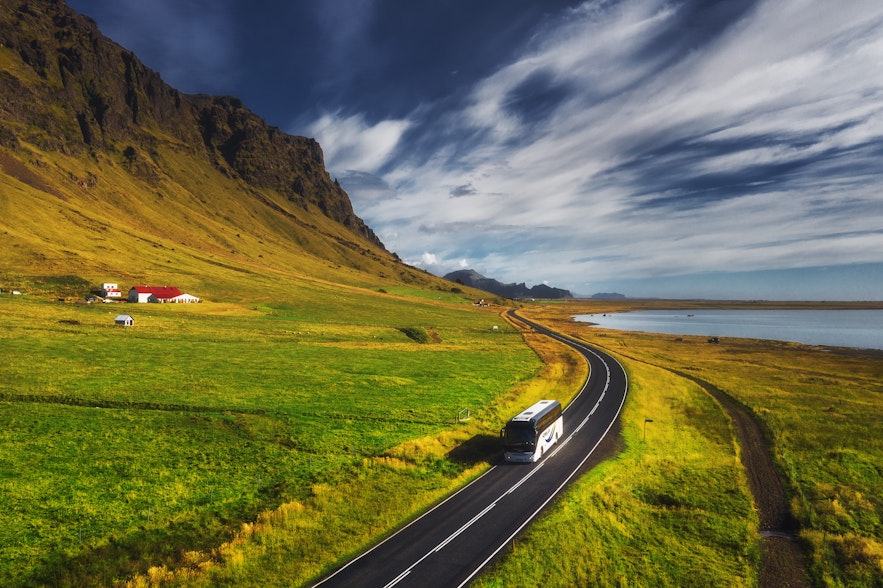
The peak season is during the summer months from June to August. This is because of the long hours of daylight, warmer weather, and the opportunity to engage in sightseeing around the country, and going on road trips on the Ring Road . The peak season shortly returns around the time of Christmas and New Year's during the last half of December into early January, as people visit to experience the festive atmosphere in Iceland during this period of the year.
The shoulder season splits in two, the first being in spring (April-May) and the second during autumn (September-October). During those periods, it's still relatively warm compared to the cold winter, and visitors can comfortably travel between attractions without much worry about snow. The days are certainly shorter than during the bright summer but still give plenty of time for sightseeing. You could even see the northern lights if conditions are right during April or October, even though it's not the prime season for aurora hunting.
Lastly, the off-peak season from November to March (minus the Christmas season!) presents the coldest weather conditions but also the greatest opportunities to see the northern lights, go glacier hiking , dog-sledding , or skiing. Note that daylight is very limited in the winter months, and certain areas may be inaccessible due to weather conditions, such as the Westfjords and the Highlands.
- Read more: 18 Things to Do & Places to Visit in Iceland
Iceland's weather varies significantly throughout the year due to its location close to the Arctic Circle. The country experiences relatively mild but unpredictable weather. Because of its proximity to the Arctic, daylight hours swing dramatically during the year. This can be good to know when deciding when to go to Iceland.
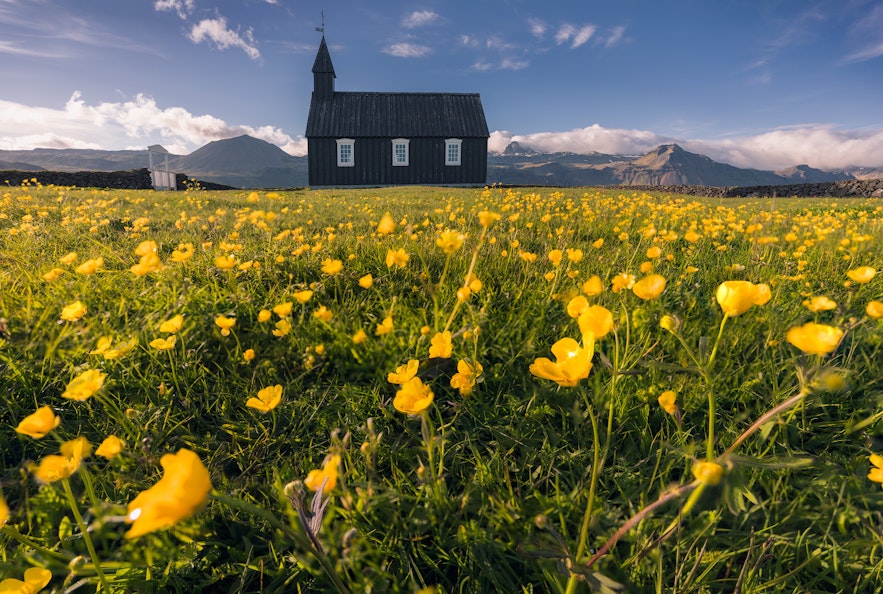
Concurrently, the daylight hours rapidly increase due to Iceland's position near the Arctic Circle. In the early spring, there can be approximately 13 to 14 hours of daylight, with the sun rising around 6 AM and setting around 8 PM in April. However, by late May, daylight can extend up to 20 to 21 hours a day. This significant increase in daylight hours, coupled with the country's blossoming landscapes, marks a vibrant and exciting time to experience Iceland's unique natural beauty.
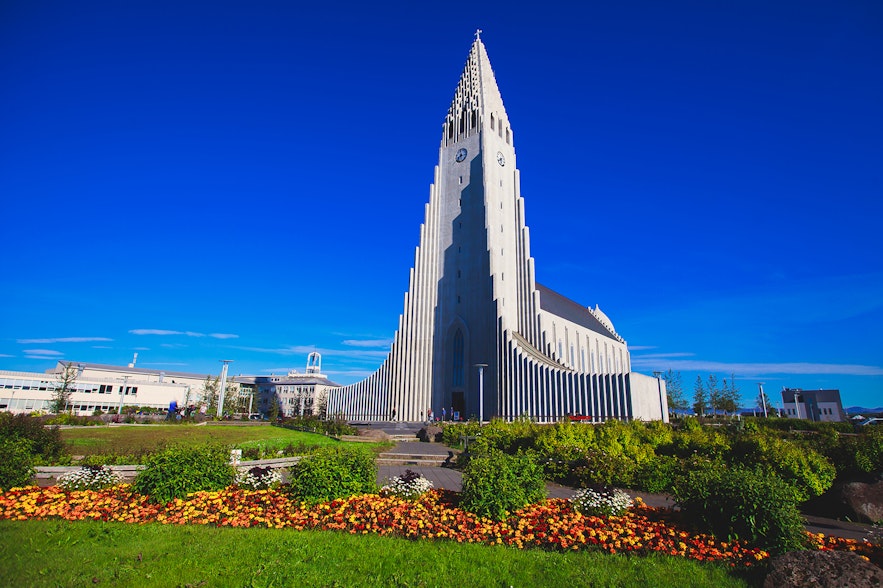
During this season, the daylight hours in summer reach their peak due to Iceland's position. In the early summer months, daylight extends remarkably, offering nearly 24 hours of daylight, peaking around the summer solstice in late June. The sun barely dips below the horizon before rising again, giving birth to the mesmerizing phenomenon known as the Midnight Sun. This astonishing period of prolonged daylight paints the landscapes in a continuous golden hue and offers extended hours for exploration.
Top Summer Tours & Packages
Outstanding 2 day tour of iceland's south coast with glacier hiking & jokulsarlon glacier lagoon.
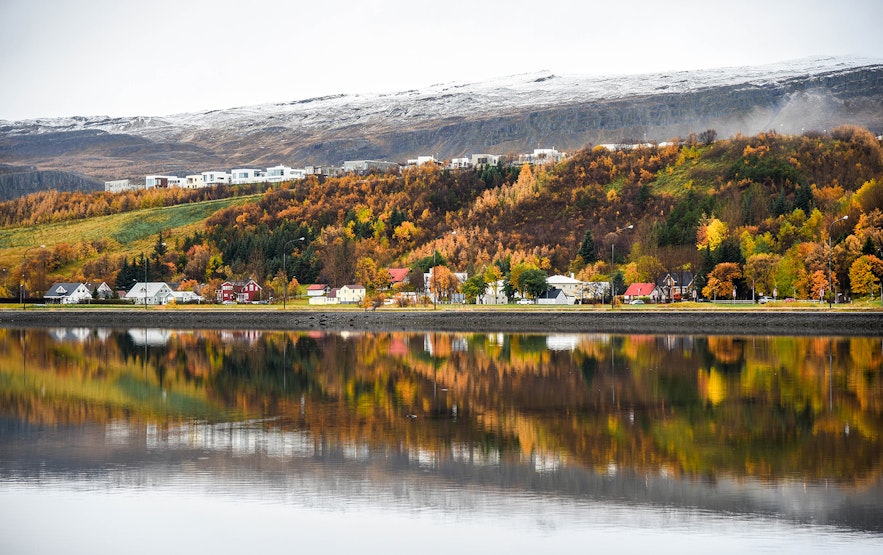
Daylight hours begin to recede during the autumn months. At the onset of autumn in September, the length of daylight begins to align more closely with the length of night, providing approximately 12 to 13 hours of daylight, with the sun rising around 6:30 AM and setting around 7:30 PM. However, by late October, daylight hours diminish to approximately 8 to 9 hours per day, with the sun rising closer to 9 AM and setting around 5 PM. This creates an opportunity to view the northern lights when the skies are dark.

In terms of daylight, winter marks the period of the shortest days in Iceland due to its proximity to the Arctic Circle. By December, daylight hours can be as short as 4 to 5 hours a day, with the sun rising around 11:30 AM and setting around 3:30 PM. However, this lack of daylight also creates the best time of year to see Iceland's most iconic natural phenomenon - the aurora borealis, which lights up the winter sky with its enchanting and colorful display.
- Learn more: Iceland's Weather, Climate and Temperature Year-Round
If you're not sure when to visit, or if you've already booked your flight and want to know what's going on when you arrive, here is a short overview for each month of the year in Iceland and what you can expect. Clicking on each of the headlines will take you to a much more detailed guide with everything you need to know about that particular month in Iceland.

Photo from Thrilling 2-Hour ATV Ride on South Coast to the DC Plane Wreck
August is the last month of pure summer bliss in Iceland, making it a great time of year for fun outdoor activities such as feeling the serenity of the water on kayaking tours , getting a rush of adrenaline while zooming across black sand beaches on ATV and buggy tours or braving the rapids of glacial rivers on epic rafting tours . If you'd prefer to take things slow and just enjoy the beauty and peacefulness of nature, go sightseeing and enjoy the many natural wonders around the country. The first weekend of August is a 3-day weekend for Icelanders, with many festivals being held around the country, the biggest one being in the Westman Islands. The festivities in August continue, with Menningarnott (Reykjavik Cultural Night) being celebrated the following weekend and Reykjavik Pride Festival the weekend after that. If you're not sure about things to do, check out our extensive selection of August tours which you can book online.
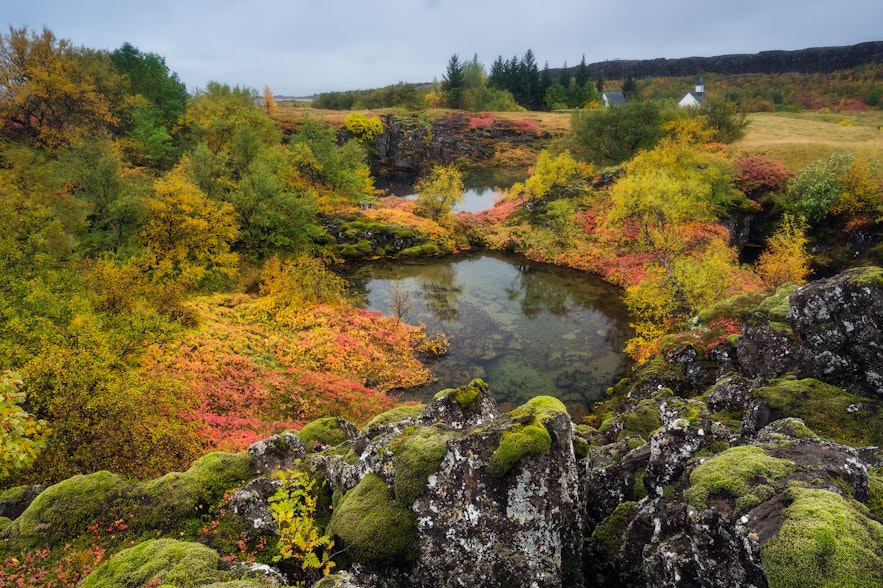
Yes, Iceland can be visited in winter. This is the best time to see the northern lights. However, keep in mind that the weather can be unpredictable and daylight hours are reduced. There is a wide range of winter tours and packages in Iceland that you can explore.
The northern lights are not visible in summer due to the long daylight hours. The best time to see them is during clear, dark nights from late September to early April. For the best chance to see these elusive lights, there are a lot of northern lights tours to choose from during the winter.
Yes, the Golden Circle is open any time of the year and is conveniently located close to Reykjavik. If you're driving yourself, it's a good idea to rent a 4x4 vehicle if you're going there during the winter in case the roads are snowy. If you don't want to drive, there is a wide variety of Golden Circle tours to choose from.
During winter in Iceland, it's important to dress in layers to stay warm and comfortable. Start with thermal underwear and add layers such as a fleece jacket or wool sweater. Over this, wear a windproof and waterproof outer layer. Don't forget to wear insulated waterproof boots with good grip, as streets can become icy. Warm socks, gloves, hats, and scarves are also essential to protect against the cold.
Even in summer, weather in Iceland can be unpredictable. Pack layers, including a warm jacket, waterproof outer layer, hat, gloves, sturdy footwear, and warm socks. Don't forget your swimsuit for geothermal lagoon visits! You can read our Ultimate Guide on What to Wear in Iceland for tips about dressing appropriately any time of year.
Yes, renting a car in Iceland is a popular way to explore the country. Do note that weather conditions can make driving challenging, especially in winter. Always check road conditions and weather forecasts before setting out.
When would you most like to visit Iceland? If you have been to Iceland, what time of year did you visit? Let us know in the comments below!
Popular articles

Guide to Iceland | The Story of the Leading Travel Agency of Iceland

The Complete Guide to the Midnight Sun in Iceland

Top 20 Most Beautiful Waterfalls in Iceland

22 Photos of the Aurora in Iceland

Mountains in Iceland
Other interesting articles.
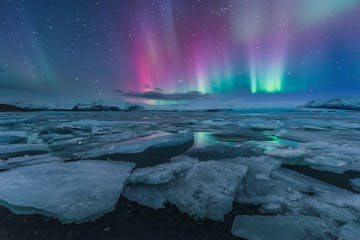
Iceland in Winter - The Ultimate Travel Guide

Best Brunch in Reykjavik
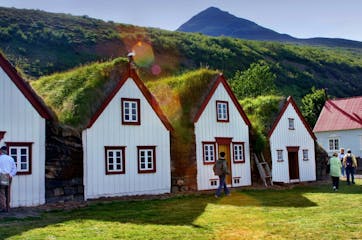
11 Must-See Destinations in North Iceland

Download Iceland’s biggest travel marketplace to your phone to manage your entire trip in one place
Scan this QR code with your phone camera and press the link that appears to add Iceland’s biggest travel marketplace into your pocket. Enter your phone number or email address to receive an SMS or email with the download link.
Top things to do in Iceland
Book your complete trip with the best companies only

Explore an Ice Cave

Visit a Live Volcano

Find the Northern Lights

Visit the Blue Lagoon

Go on a Road Trip

Do the Golden Circle

See the Glacier Lagoon

South Coast Tours
Weather & Climate
Top Places to Visit in Iceland
Keflavik International Airport Guide
Driving in Iceland
Tipping in Iceland
Staying Safe in Iceland
Helpful Words and Phrases
Best Tours in Iceland
Top Northern Lights Tours
Seven-Day Iceland Itinerary
48 Hours in Reykjavik
Day Trips From Reykjavik
Top Things to Do in Iceland
Best Beaches in Iceland
Hiking in Iceland
How to See the Northern Lights
Best Icelandic Hot Springs
Skiing in Iceland
Top Things to Do in Reykjavik
Free Things to Do in Reykjavik
Reykjavik's Best Museums
Shopping in Reykjavik
Guide to the Blue Lagoon
Food to Try in Iceland
Best Restaurants in Reykjavik
Top Reykjavik Bars
Craft Beer in Iceland
Best Time to Visit
The Best Time to Visit Iceland
While there are many unique travel opportunities , various adventures, and great events year-round in Iceland, the best time to visit Iceland is in June when the weather starts to warm up and the country experiences 24 hours of sunlight.
However, if you're planning your first trip to Iceland , the best time of year to explore this Nordic island nation really depends on what you're looking for—whether you prefer warmer weather and outdoor events or you don't mind a little bit of cold for a great nightlife scene. When it comes to deciding what time is right for your trip, you should consider when to expect the biggest and smallest crowds, warmest or coldest weather, and highest or lowest costs for airfare and accommodations.
Peak Season in Iceland
Undoubtedly, July through the early August is the busiest time of year for Iceland's tourism industry, but crowd sizes and travel prices start going up in May and June and don't really start going down until September. If you're looking to avoid lots of tourists and to save money on your trip while still being able to access popular attractions, you might consider visiting in the shoulder season, which happens from early April to mid-June and mid-September to early November each year.
The dead of winter, which runs from early December through mid-March, is the official off-season for Iceland, but a boom in year-round tourism since 2008 has resulted in prices for airfare and accommodations stabilizing over the years as more travelers have discovered the joys of this Nordic country's coldest season. However, you can still find great prices on last-minute airfare and even some special travel deals from the United States this time of year.
Weather in Iceland
Don't let the name Iceland fool you: The winters here aren't particularly bad; temperatures average 32 degrees Fahrenheit in the lowlands and 14 degrees Fahrenheit in the highlands for most of the season. However, temperatures can dip down to 22 degrees below zero in the northern part of the country, so you'll want to avoid that area if you visit during the winter. June is the country's driest month of the year, while July is the warmest month of summer, with an average temperature of a pleasant 60 degrees Fahrenheit, and the weather in Iceland usually stays mild until late August.
When to See Natural Phenomena in Iceland
Known as a country of mystical landscapes and breathtaking vistas, one of the main reasons people visit Iceland is to enjoy its natural phenomena, including the Aurora Borealis (Northern Lights), the Midnight Sun, and the Polar Nights.
While nearby Norway may be home to the best places to see the Northern Lights , there are plenty of great spots in northern Iceland to catch a glimpse if you visit from mid-October through March, a period known as the Polar Nights when the country experiences up to 19 hours of darkness a day. However, if you're a creature of the sun, you may prefer to travel in the summer instead when the Midnight Sun results in over 20 hours of daylight from June through August.
While some attractions might not yet be open in March or April, which is the best time to see the snow giving way to lush greenery and wildlife, you're sure to find plenty worthy of exploring. Spring is particularly great for visiting unique destinations like the many remote hot springs spread across the country as their access roads are buried under snow all winter.
Events to Check Out
- Puffins arrive on the island each year in April.
- National Beer Day is held each year on March 1, celebrating the end of Iceland's prohibition. There are several craft beers now available. Pubs and restaurants throughout the country celebrate.
Summer in Iceland is one of the best times to visit because the weather is pleasant and the sun barely sets. If you'd prefer longer days to explore the outdoors and hike the defrosted fjords, you'll love that there are about 20 hours of daylight (on average) each month of this season. Along with seasonal events—including outdoor concerts and festivals celebrating art, culture, and music—Iceland provides ample opportunity during the summer to explore the highlands and thawed fjords, swim in crystal-clear mountain lakes, and hike around the gorgeous island landscape.
The drawback to summer, though, is that prices are generally higher across the board—on food, accommodations, attractions, rentals, and airfare. Additionally, lines are longer, hotels fill up, and restaurants run out of room on their reservation lists as tourists flock to the most popular spots during the long daylight hours of Iceland's summer.
- The Viking Festival takes place in June in Hafnarfjörður. It's the oldest festival of its kind in the country.
- June 17 is Icelandic National Day, a celebration of the young country's independence.
If you visit in September through mid-October, you'll have an even better opportunity to enjoy the hot springs since there will be fewer crowds and you won't have to rely on snow melting to access these remote destinations. Additionally, some of the best opportunities to see the Northern Lights are on clear autumn nights in late October through early December, before winter weather settles in and blocks the view with thick clouds.
- The annual Iceland Airwaves music festival takes place in Reykjavik in November and showcases new music from around the world.
- One of Iceland's oldest traditions is réttir, an annual island-wide sheep round-up that take place during September.
Summer has the benefit of long days but come winter, daylight shrinks to about five hours in a period called the Polar Nights . If you can endure little sunlight, the question of when to visit Iceland suddenly becomes much harder because Iceland also has many bolder things to offer in winter: never-ending nightlife in Reykjavik , infinite chances to view the Northern Lights , and plenty of outdoor snow activities such as skiing, snowboarding, and snowmobiling.
The colder part of the year is also when flight prices to Iceland fall drastically and local hotels suddenly cut prices by more than half. Budget travelers wondering when to go to Iceland should aim for February or March because those months have more daylight than the earlier winter months but still the smallest crowds and the lowest prices.
- Winter means Christmas markets, which are abundant throughout Iceland. One of the best is Heiðmörk Christmas Market, about a 20-minute drive from Reykjavík.
The best time to visit Iceland depends on what you're looking for, but June is one of the best months for visiting. It's before the peak tourist season begins and the midnight sun phenomenon is incredible to experience.
The off-season is the cold winter months, especially from November to April. Prices go up in the weeks around the holidays, but outside of those dates it's the cheapest time to visit Iceland.
The peak season in Iceland is July and August when the days are at their warmest. Prices start going up in May and June, but you'll still find cheaper rates than you will in the late summer.
Guide to Iceland. "Weather in Iceland & Best Time To Visit." Retrieved February 10, 2021.
Weather in Iceland: Climate, Seasons, and Average Monthly Temperature
Weather in Norway: Climate, Seasons, and Average Monthly Temperature
The Best Time to Visit Sweden
Scandinavia and the Nordic Region: Planning Your Trip
The Best Time of the Year to Visit Norway
The 10 Best Things to Do in Iceland During the Winter
The Best Free Things in Reykjavik, Iceland
The Best Time to Cruise Alaska
The Best Time to Visit Mexico
The Best Time to Visit Spain
The Best Time to Visit the Bahamas
The Best Time to Visit Boston
Your Trip to Iceland: The Complete Guide
The Best Time to Visit Morocco
The Best Time to Visit the Dominican Republic
The Best Time to Visit Japan

IMAGES
VIDEO
COMMENTS
Now, if you are interested in heat rather than warmth, July might be a better time to visit Iceland. It is the best time of year to visit Iceland for heat, as the hottest month of the year. It is also the least windy month. The weather in Iceland in July is generally extremely pleasant during this time of the year. While the nights are a little ...
June to August is the best time for outdoor recreation. While there’s no good weather guarantee, this is your best chance of sun and warmish temperatures. Late June to early August is when most Icelanders go on vacation, filling up campgrounds wherever the best weather is forecast. This is the height of the tourist season – and height of ...
May is the best time to visit Iceland if you’re wanting a good balance between crowds, costs, and climate. The days are lovely and long, if a little chilly, there are fewer tourists, and prices are still low . Temperatures are still fairly low, with the average maximum rarely peaking over 10°C.
Best Time to Visit Iceland for Whale Watching According to Icelandic marine biologist Edda Elísabet Magnúsdóttir, the peak months to go whale watching in Iceland are June and July.
For camping enthusiasts, the best time to visit Iceland is during the summer months, particularly from June through August. This period offers milder weather conditions and extended daylight hours. All the camping sites around the country, including those in more remote highland locations, are generally open and accessible during this period.
The Best Time to Visit Iceland. While there are many unique travel opportunities, various adventures, and great events year-round in Iceland, the best time to visit Iceland is in June when the weather starts to warm up and the country experiences 24 hours of sunlight. However, if you're planning your first trip to Iceland, the best time of year ...